INTRODUCTION TO SAN PEDRO

I finally visited San Pedro for California Fool’s Gold. It’s long been one of my favorite Los Angeles neighborhoods but in general (and in this case), I rely on you, the vox populi, to tell me where I should go.
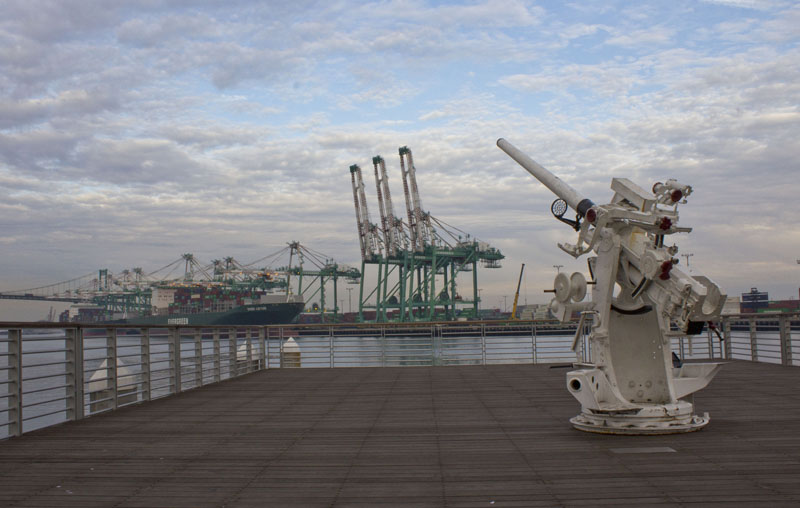
San Pedro is a neighborhood in Los Angeles’s Harbor District (or Harbor Area or simply, the Harbor). It’s neighbored by Rancho Palos Verdes to the west, Lomita to the northwest, Harbor City to the north, Wilmington to the northeast, and Long Beach to the east. The southern edge is formed by the San Pedro Bay, and across that is the island of Santa Catalina.
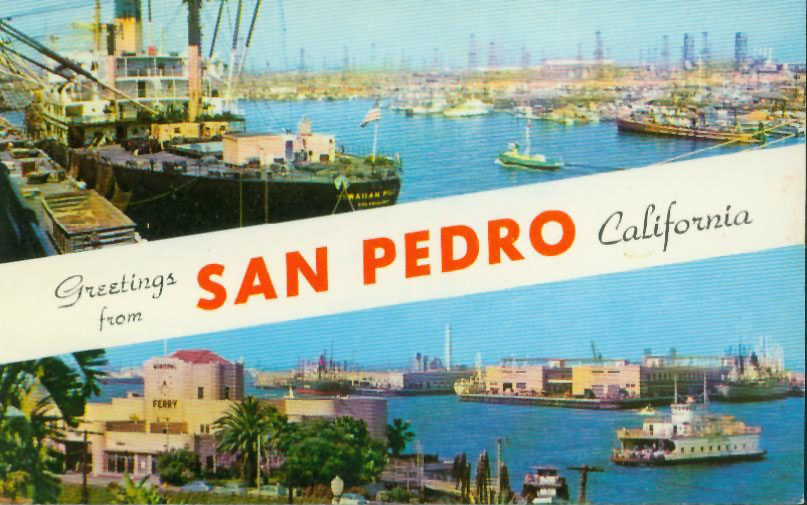
Like Eagle Rock, Garvanza, Highland Park, Hollywood, Hyde Park, Sycamore Grove, Venice, Wilmington, and other Los Angeles neighborhoods; San Pedro was once an independent municipality. Unlike most of those, however, San Pedro retains an undeniable air of autonomy, with its own downtown, its own city hall, and its own neighborhoods. People as often refer to it as a “town” as a “neighborhood.” Most Los Angeles writers usually only mention San Pedro when trying to make some point about neighborhoods they think of as remote, forgotten, or obscure. Perhaps that’s in part because even though the Harbor is no more geographically marginal than the Westside, it has absolutely nothing to do with the celebrity culture and Hollywood industry which so captivate the column inches of most things written about Los Angeles, whether by locals or The New York Times. And even though the San Pedro Bay is just as coastal as the Santa Monica Bay, where the latter is all surf, sand, and sun, the Harbor and San Pedro in particular, is more port, pollution, and Popeye.
Aside from the air pollution, I like nearly everything about San Pedro and the Harbor Area. I was therefore happy when San Pedro climbed to the lead in the poll and when my friend, Mike, asked if I’d take him to Sunken City, I said yes, splashed on some bay rum, and listened to my Harbor mix to get in the spirit. I thought about wearing a marinière, pea coat, and Greek fisherman’s cap but I didn’t want to go “full cosplay.”
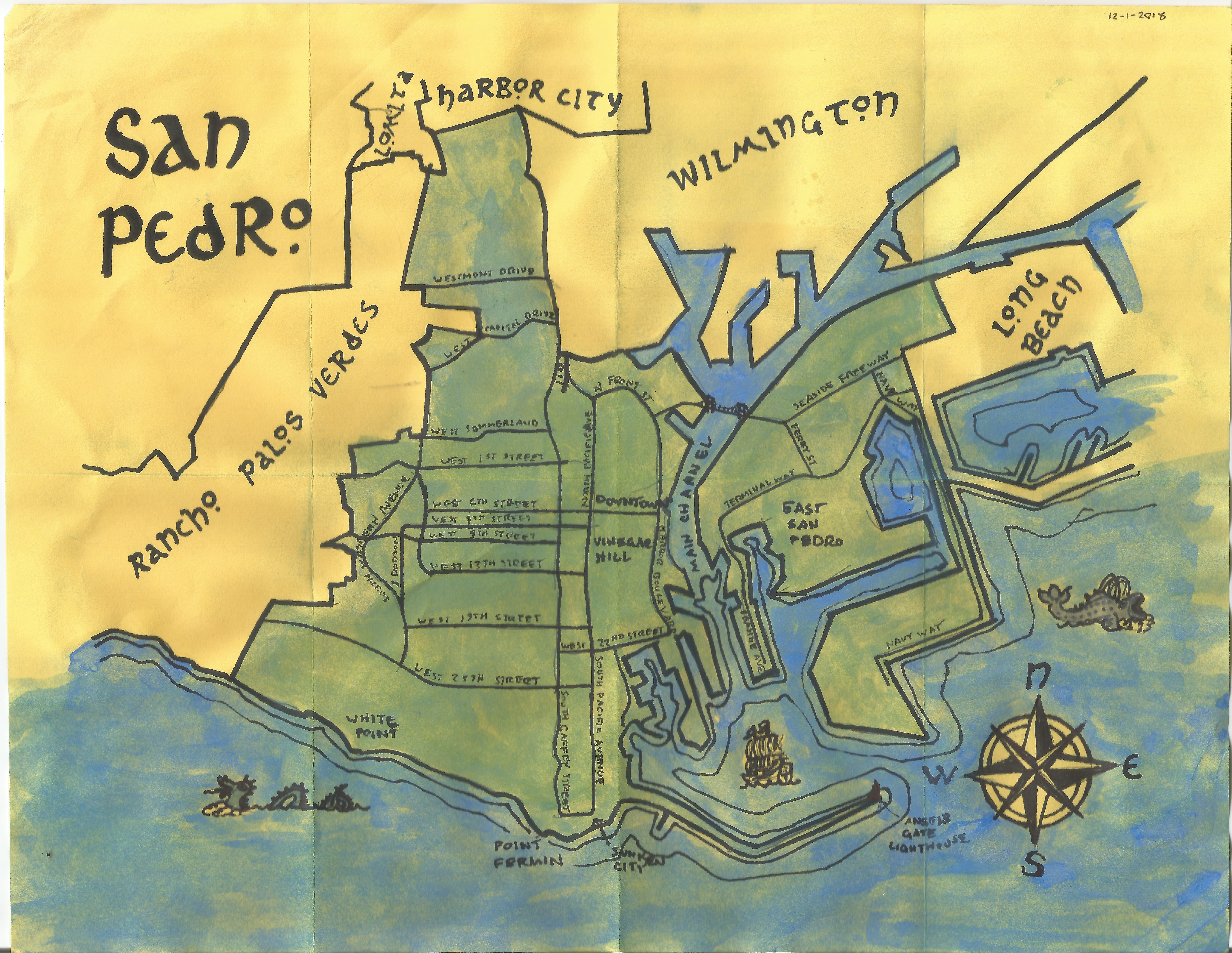
NATIVE PERIOD
The first people to settle what’s now San Pedro were possibly the ancestors of the Chumash. Roughly 10,000 years ago, they people settled the Channel Islands and some of the adjacent coastal region of the Los Angeles Basin. Thousands of years later, the Tongva arrived from the east and, possibly following a depopulation of inland areas prompted by a prolonged drought, apparently found much of the inland Los Angeles Basin relatively unpopulated by humans. The Tongva also settled some of the Channel Islands and coast. On the islands of San Nicolas and San Clemente, there are signs of battles fought between warring peoples and at the time of Spanish contact, it was the Tongva who were living on them as well as Santa Catalina, which they referred to as Pimu’nga. Across the waters, in what’s now the San Pedro Area, the Tongva established the villages of Ataavyanga, Chaawvenga (Chowigna), Kiingkenga, Moniika’nga, Xaraashanga, and Xoyuunga (Suangna).
SPANISH PERIOD
The first Spaniard to arrive in San Pedro Bay was Juan Rodríguez Cabrillo, who arrived on 8 October 1542. Cabrillo named the area San Pedro although the Spanish also alternately referred to the area as the “Bahía de los Fumos.” The source of San Pedro’s smoke is unclear. Some point to wildfires and others to village cooking fires or controlled burns used for hunting and clearing pasture. All could’ve contributed, with the naturally occurring fog, to create smog as well.
I wonder whether or not the Spaniards were witnessing smoke signals being sent between the Tongva of San Pedro Bay and those on Santa Catalina — the latter whom Cabrillo and crew had made first contact with the previous day. The Tongva of Santa Catalina — who referred to themselves as Pimugnans or Pimuvit — were regularly in contact with the Tongva of San Pedro Bay and it seems natural that they’d want to give their neighbors a heads up that they were about to have company.
In 1602 and 1603, Spaniard Sebastián Vizcaíno surveyed and mapped the California coastline, including San Pedro Bay, for New Spain. European settlement began in 1769 and Rancho San Pedro was one of the first Spanish land grants in Alta California, granted in 1784 by King Carlos III. The recipient, Juan Jose Dominguez, was retired Spanish soldier who’d come to California as part of the Gaspar de Portolà expedition.
MEXICAN & AMERICAN PERIOD
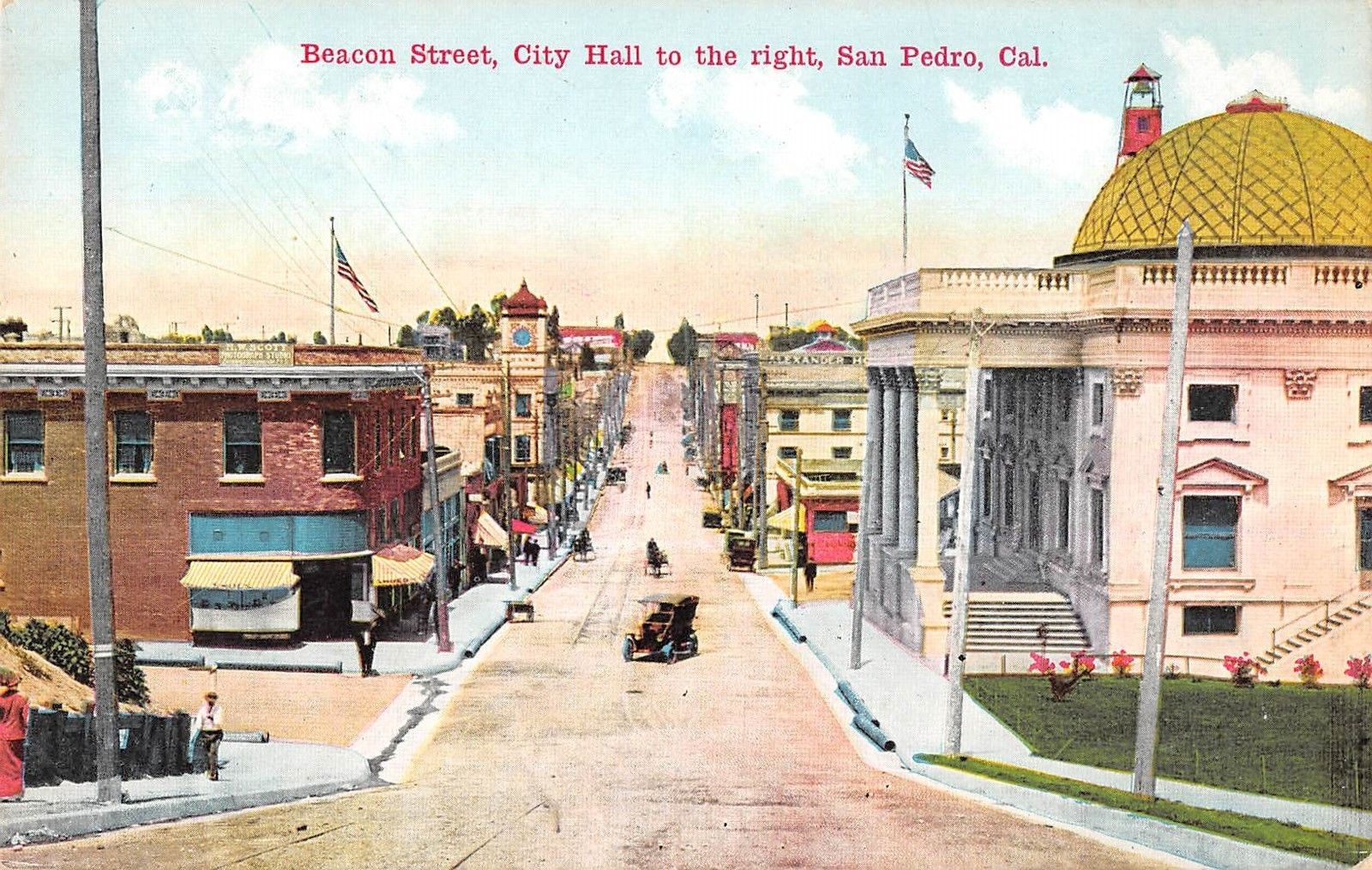
Mexico declared independence from Spain in 1810. In 1821, their independence was recognized. 25 years later, the United States invaded Mexico, defeating them in 1848. California became the 31st state in 1850 and the victorious Americans renamed Isla Raza de Buena Gente (now Terminal Island) “Rattlesnake Island.” They kept the name, San Pedro, however, although at some point, altered the pronunciation to “San Peedro.” Nowadays, anyone who pronounces the name with a proper Spanish accent will be shamed for not sounding like a local. I can’t help but wonder whether or not the reverse situation took place in the 1860s when English overtook Spanish as Los Angeles’s lingua franca.
PHINEAS BANNING — FATHER OF THE HARBOR

The harbor was greatly improved and expanded under the guidance of Phineas Banning and John Gately Downey, the seventh governor of California. In 1858 Phineas Banning founded the town of Wilmington. Banning operated stagecoach lines to Salt Lake City and Yuma and in 1868 added a railroad line, the Los Angeles & San Pedro Railroad, from San Pedro to Los Angeles — the first in the region. The railroad was used to transport goods from San Pedro Bay to Los Angeles, then 27 kilometers to the north. The first private ferry between San Pedro and Rattlesnake Island was launched in 1870. In 1871 Banning dredged a three-meter deep channel to Wilmington which allowed the port to increase its shipping traffic that year to about 45,000 metric tons. Banning died in 1885 but the port has continued to grow ever since and is now the busiest outside of East Asia.
ANNEXATION
In 1891, the Terminal Land Company purchased the Terminal Island and built a railway, Los Angeles Terminal Railway Company, which terminated on the eastern half of the island, which they renamed “Terminal Island.” Meanwhile, the Southern Pacific Railroad’s Collis P. Huntington was promoting nearby Santa Monica Bay as a deep harbor and built the Long Wharf there in 1893. In 1897, thanks largely to the efforts of Los Angeles Times publisher Harrison Gray Otis, San Pedro Bay got the federal endorsement and breakwater construction began in San Pedro Bay in 1899. The Los Angeles Board of Harbor Commissioners was founded in 1907. In 1906, Los Angeles annexed the Harbor Gateway, a long “shoestring” strip of land connecting the then-still-landlocked city to the Harbor towns of Wilmington and San Pedro, both of which Los Angeles annexed in 1909.
CHARACTER
San Pedro has long been one of Los Angeles’s most diverse communities. In the American period, San Pedro became home to substantial populations of blacks, Croatians, Danes, Filipinos, Greeks, Irish, Italians, Japanese, Mexicans, Norwegians, Portuguese, and Swedes. It’s still pretty diverse today. As of the 2010 census, 44.2% of its population self-identified as non-Latino white, 40.8% as Latino of any race, 6.1% as black, and 4.8% as Asian. Of the foreign-born population, 49.8% were born in Mexico and 4.4% in Italy. The most common ancestries are also Mexican (31.5%) and Italian (8.4%).
A section of South Cabrillo Avenue is still known locally as Via Italia. Many of the community’s Croatians came from the islands of Brač, Hvar, Korčula, and Vis, and a stretch of 9th Street is colloquially known as Croatian Place. The Dalmatian-American Club (founded in the 1920s by the Star-kist owner as the Yugoslavian-American Club) still stands on South Palos Verdes Street. The Norwegian presence is reflected by the presence of the Den norske sjømannskirke (Norwegian Seamen’s Church). The Japanese formerly lived mostly in the fishing village of Furusato which was mostly redeveloped after the Japanese were interred in concentration camps during World War II. In East San Pedro there’s the Terminal Island Japanese Memorial, dedicated in 2002.
VINEGAR HILL
One of the oldest neighborhoods in San Pedro, and currently its only Historic Preservation Overlay Zone (HPOZ) is Vinegar Hill. The strange name supposedly arose from the sour smell of the neighborhoods once prolific home winemaking operations. Furthermore, a stretch of 9th Street was apparently colloquially known as “Saloon-Keepers Row.” Many of the homes within the HPOZ were constructed between 1886 and 1927 and a variety of architectural styles are represented including American Colonial, American Foursquare, California Craftsman, Queen Anne, and Spanish Colonial Revival.
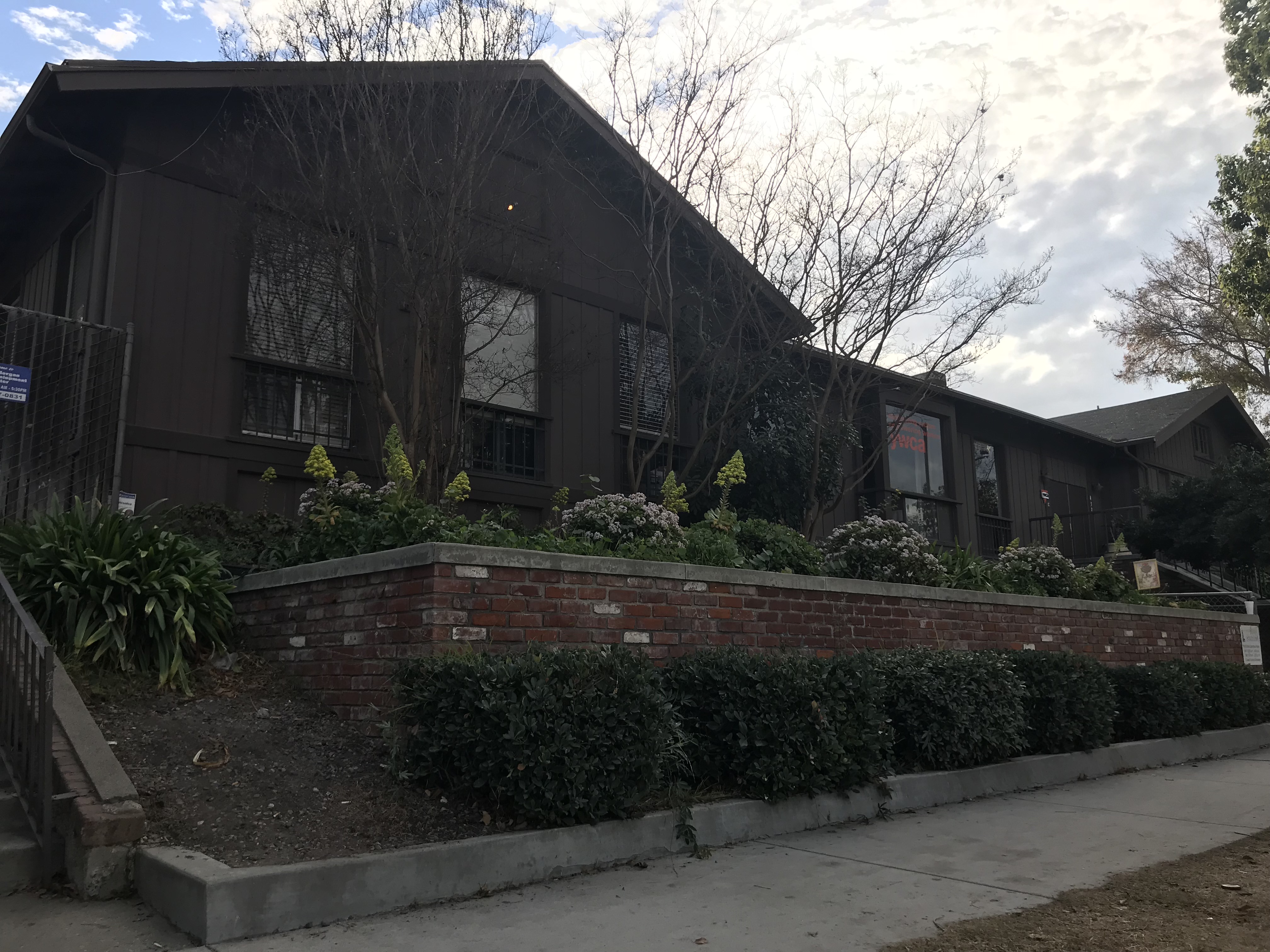
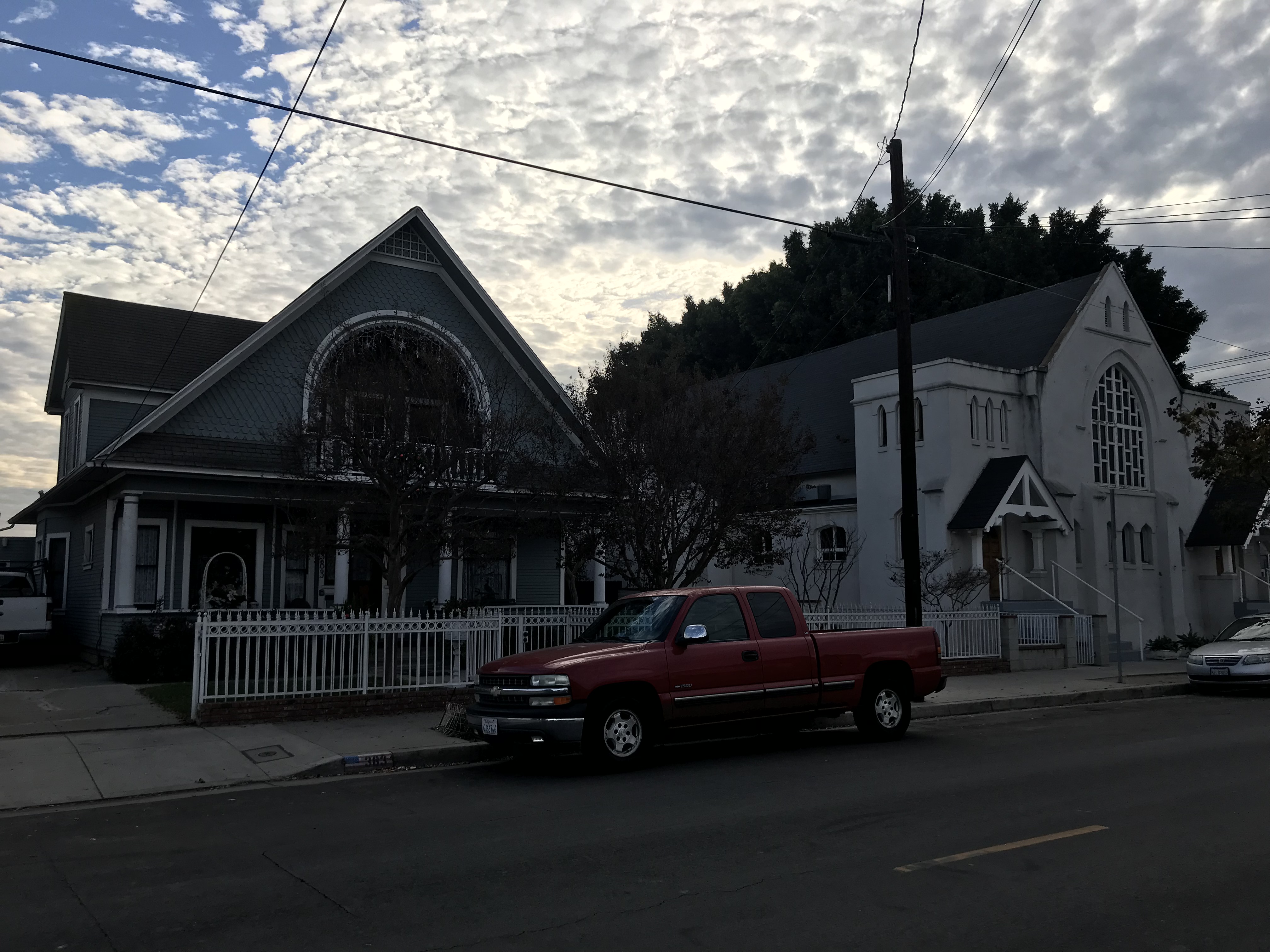
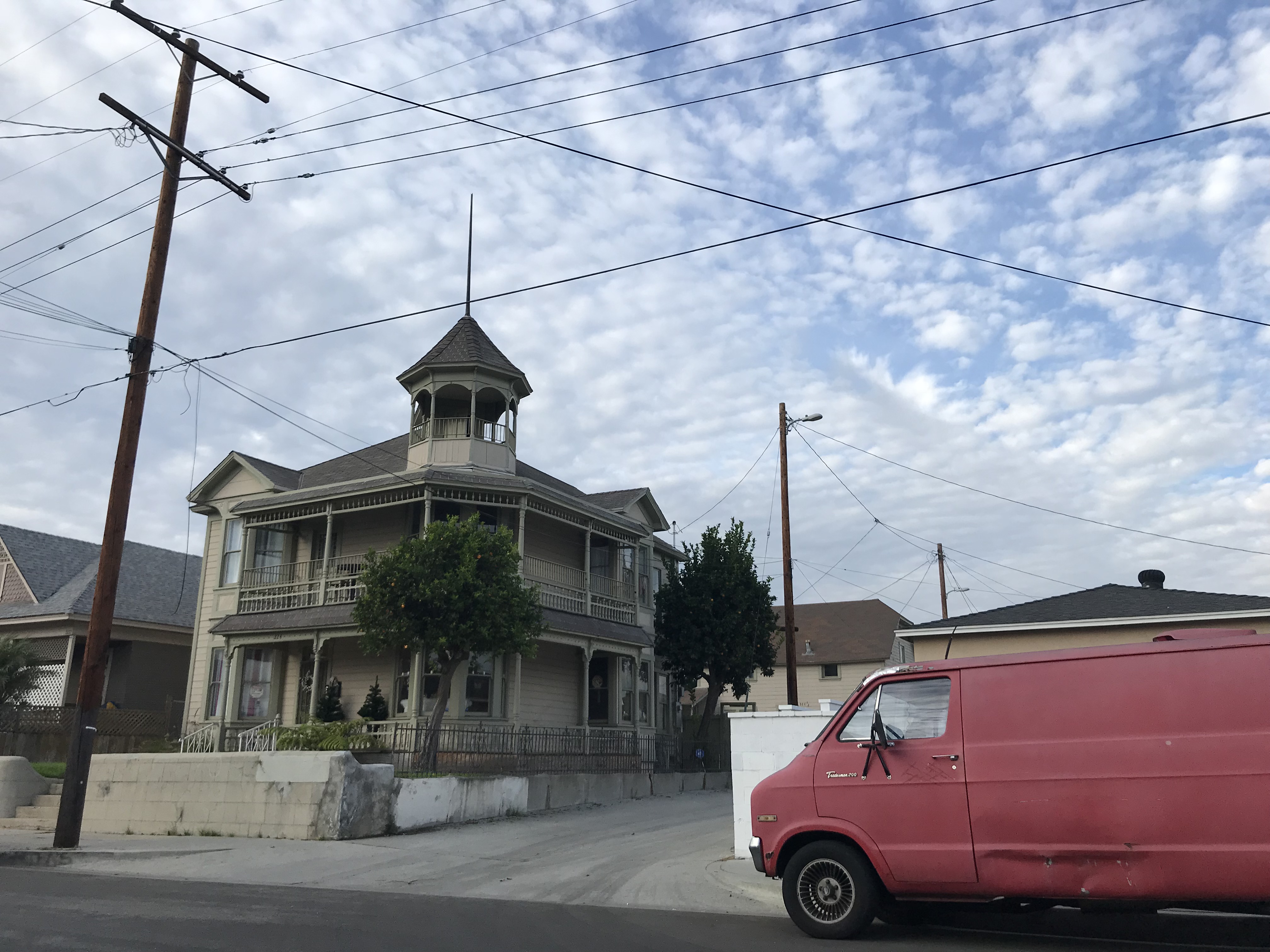
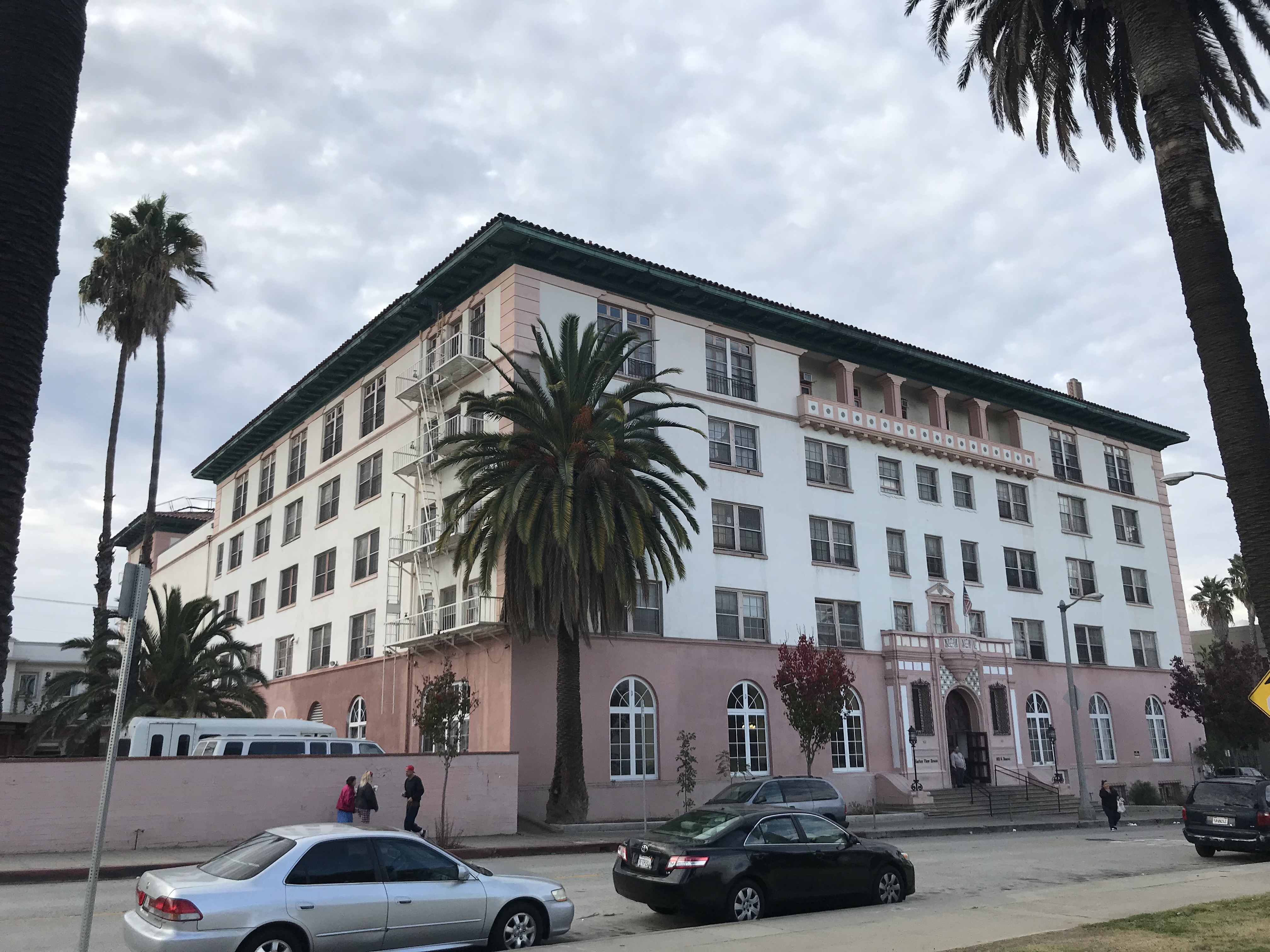
Some of the noteworthy structures in the neighborhood include the so-called Danish Castle, a Victorian home built in the 1880s by a Danish sea captain, the Harbor View House, a five-story building constructed as a recreation center for servicemen in 1926 and now the state’s largest mental health facility, a Colonial Revival home at 383 10th Street built in 1907 and made a Los Angeles Historic-Cultural Monument in 2008, and the YWCA of the Harbor Area & South Bay, built in 1918 and designed by the great Julia Morgan.
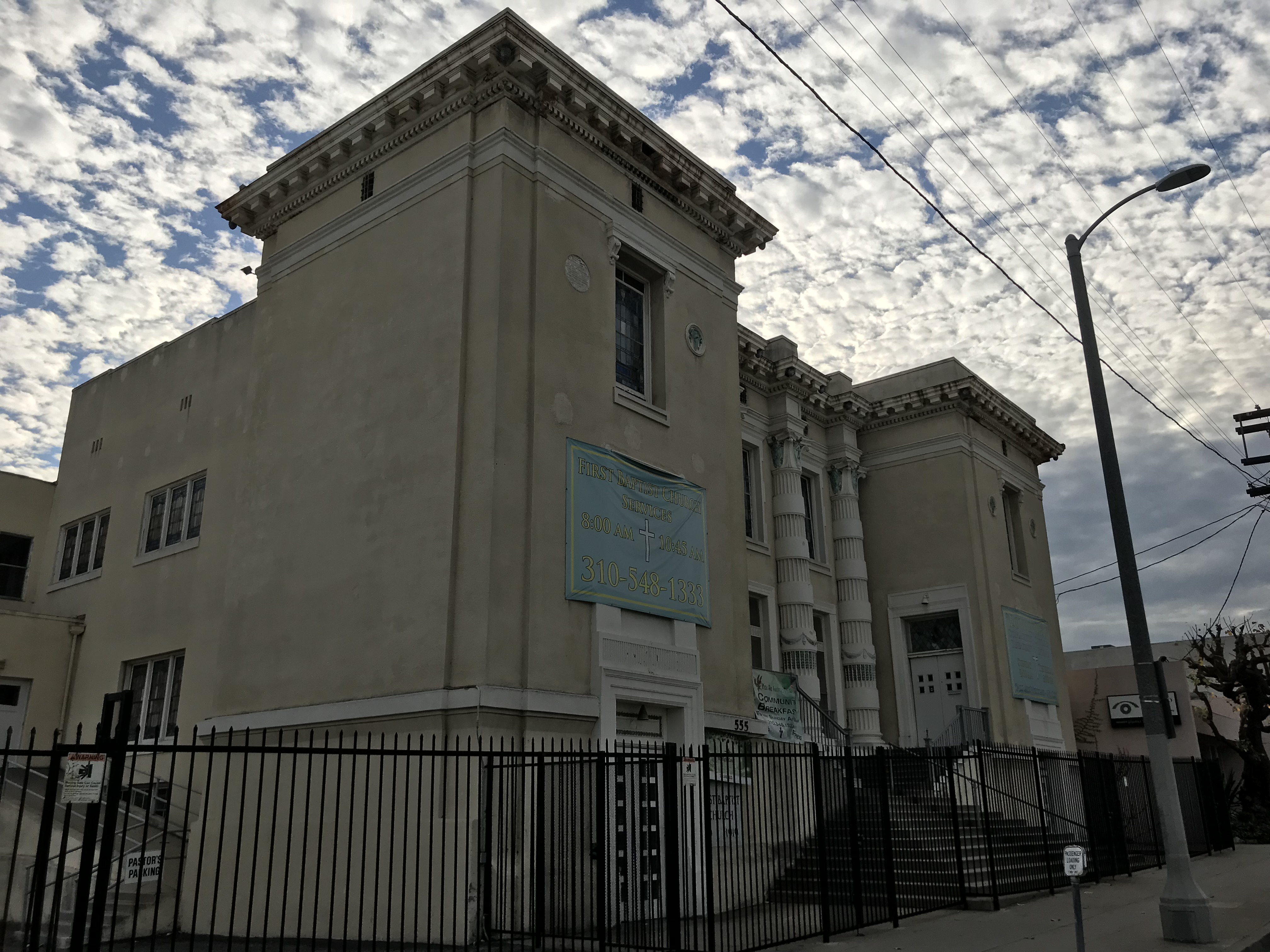
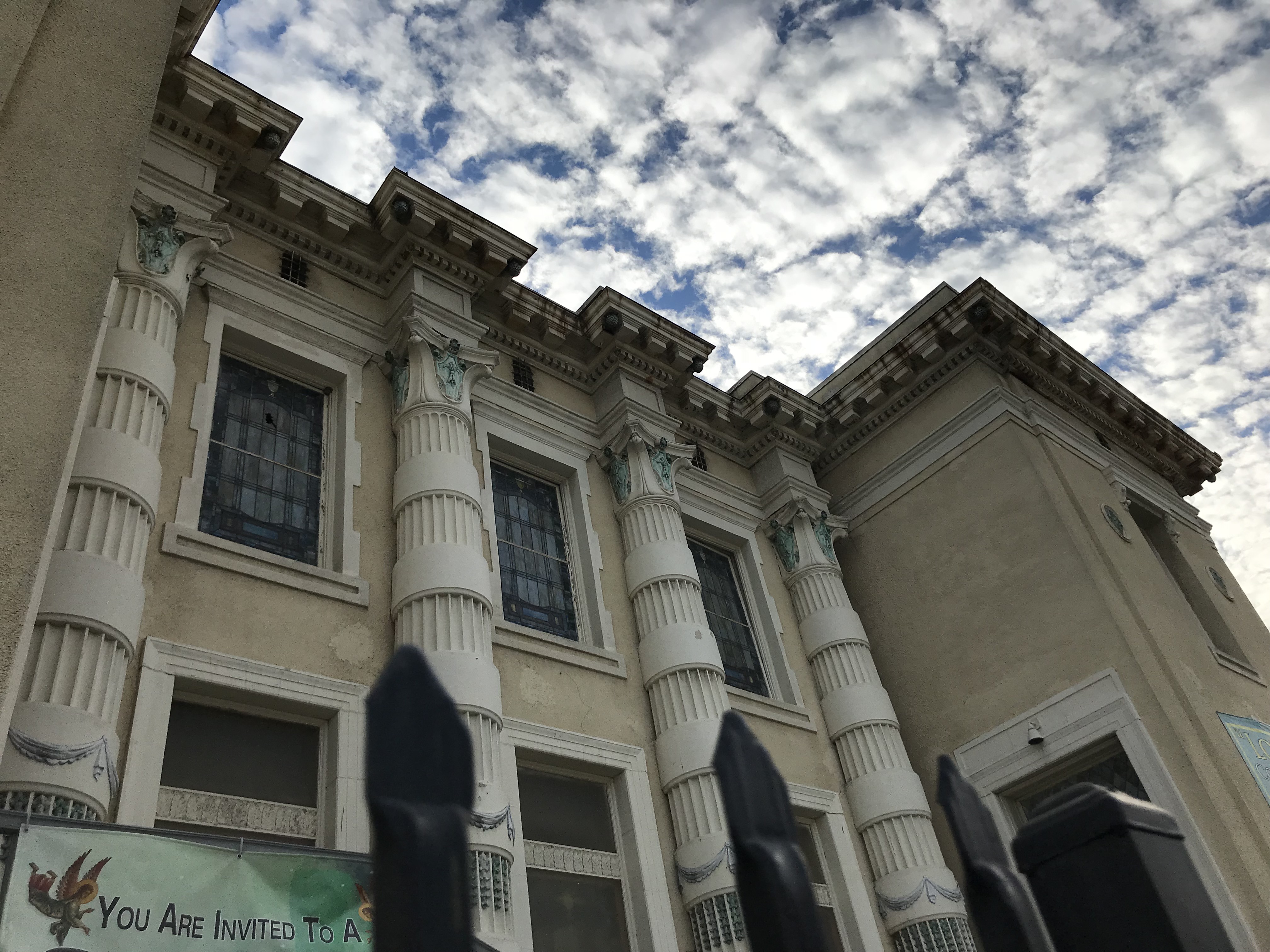
Just a bit west of Downtown and San Pedro is First Baptist Church of San Pedro — a Beaux Arts Classical church designed by Norman F. Marsh and built in 1919 with Egyptian columns and stained glass windows. In 1990, it was designated Los Angeles Historic-Cultural Monument No. 505.
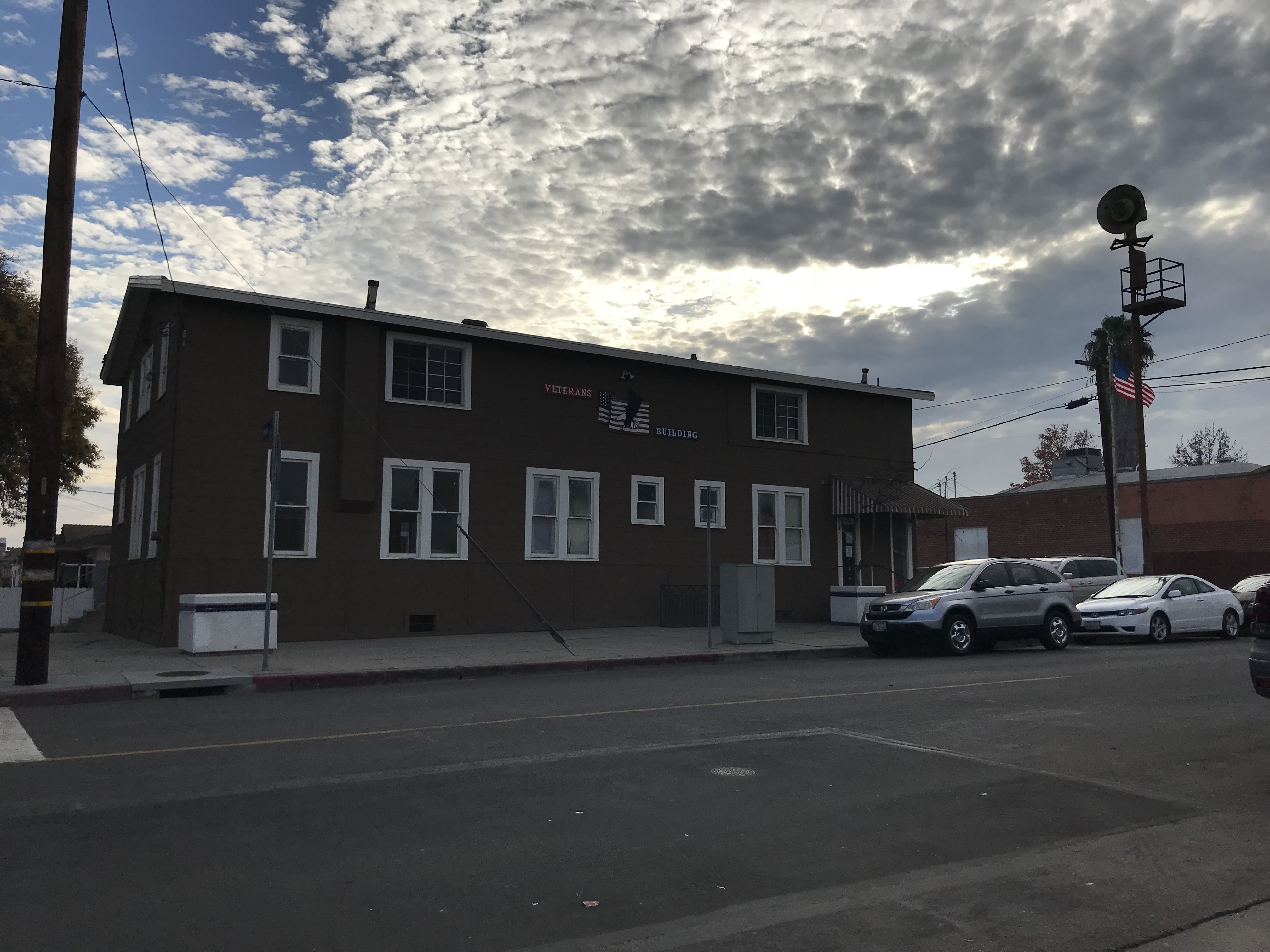
Also nearby is the old Veteran’s Building, built in 1920. Today it’s operated by the Beacon House Association of San Pedro, which offers classes and hosts daily twelve-step programs. Standing in front is the old Air Raid Siren No. 164. Beacon House currently operates eight such facilities in San Pedro.
NAVY IN SAN PEDRO
San Pedro has long and strong ties to the military. In 1888, the War Department took control of a tract of land next to the San Pedro Bay which developed into Fort MacArthur. In 1919, the US relocated the Navy‘s Pacific fleet from San Diego to San Pedro after the former proved too shallow for increasingly large warships and too distant from fuel supplies. Today the battleship USS Iowa (BB-61) is moored in San Pedro and now serves as a museum. It should be noted that Iowans who show proof of residence can come aboard for free but those actually born in Iowa, such as myself, will find this courtesy unextended to them. It’s a big ship and very much worth visiting but Mike and I skipped it because these winter days are short and you want to be able to spend more time there than we had remaining daylight.
San Pedro is also home to the Los Angeles Air Force Base, Fort MacArthur Annex, still an active base. It’s home to military personnel stationed at nearby Los Angeles Air Force Base in El Segundo. From 1914-1979 it was used by the Army. It was transferred to the Air Force in 1982.
SOUTHERN CALIFORNIA ACLU
There’s also a long and strong labor presence in San Pedro. Liberty Hill was
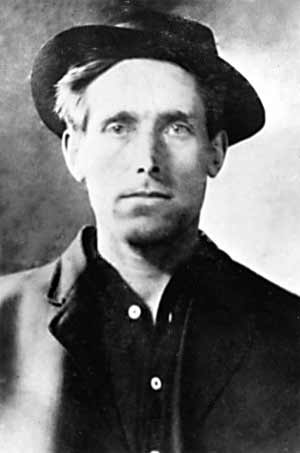
the birthplace of the ACLU of Southern California. In 1923, social activist Upton Sinclair, Hunter S. Kimbrough, his brother-in-law, Prynce Hopkins, and Hugh Hardyman were all arrested for reading from the Bill of Rights at the intersection of 4th and Beacon streets, during a strike by longshoremen who were protesting low wages, bad working conditions, and the imprisonment of union activists. A plaque was dedicated to the protestors in 1998. Early last year, a bronze memorial was unveiled on Liberty Hill dedicated to Joe Hill (né Joel Hägglund), an Industrial Workers of the World (IWW) organizer (or “wobbly”), agitator, singer, and poet.
ANGELS GATE AND POINT FERMIN
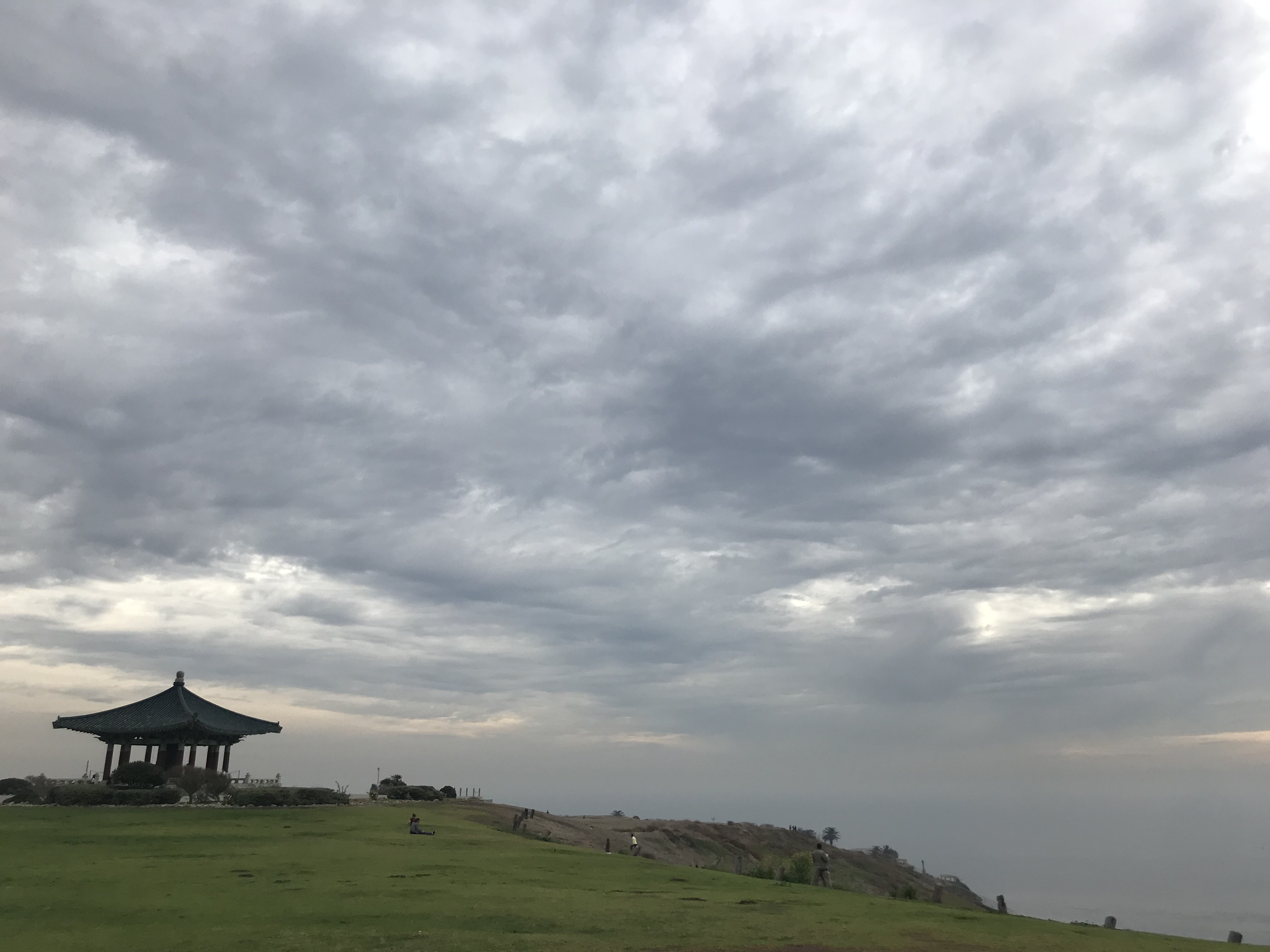
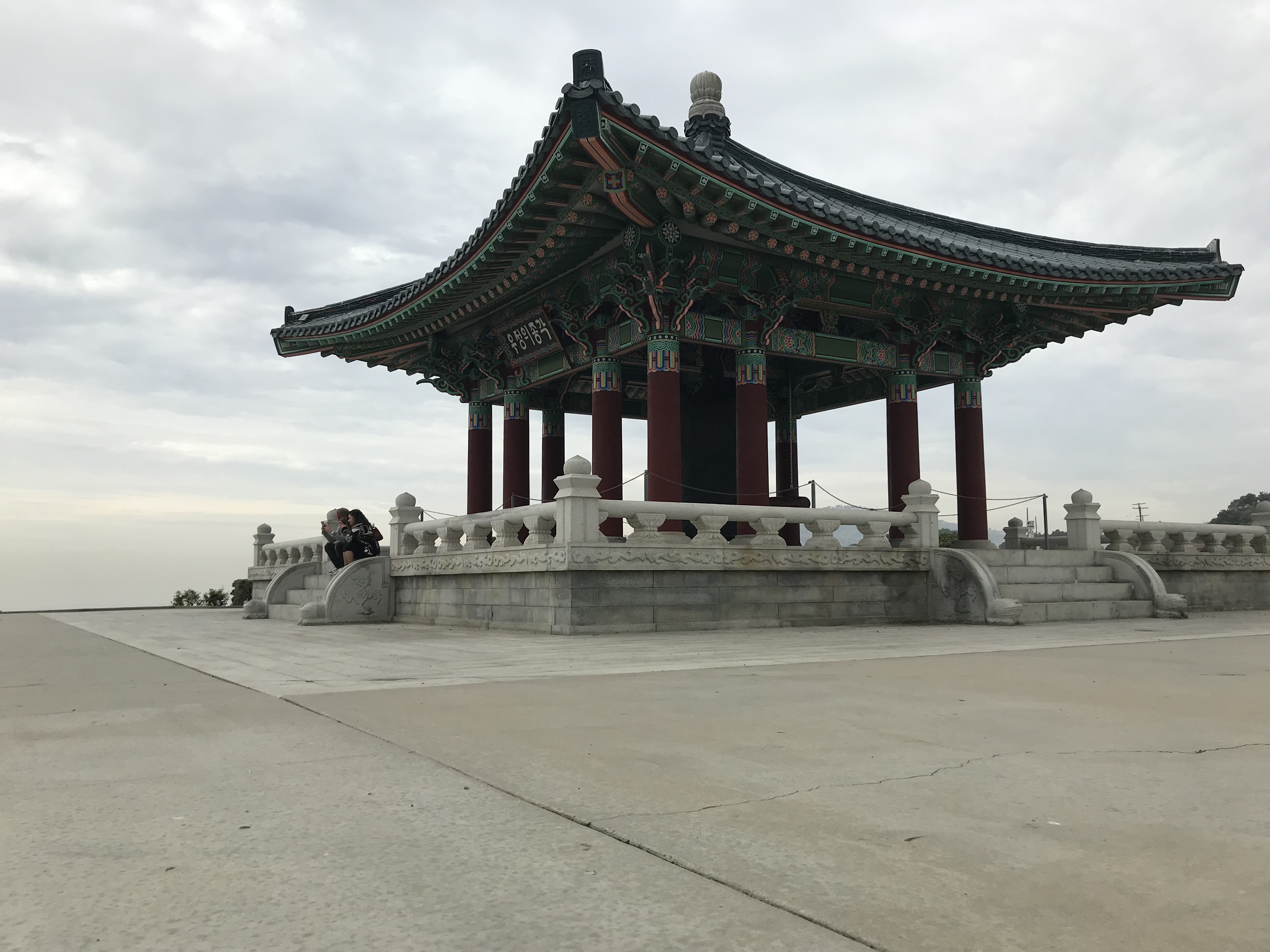
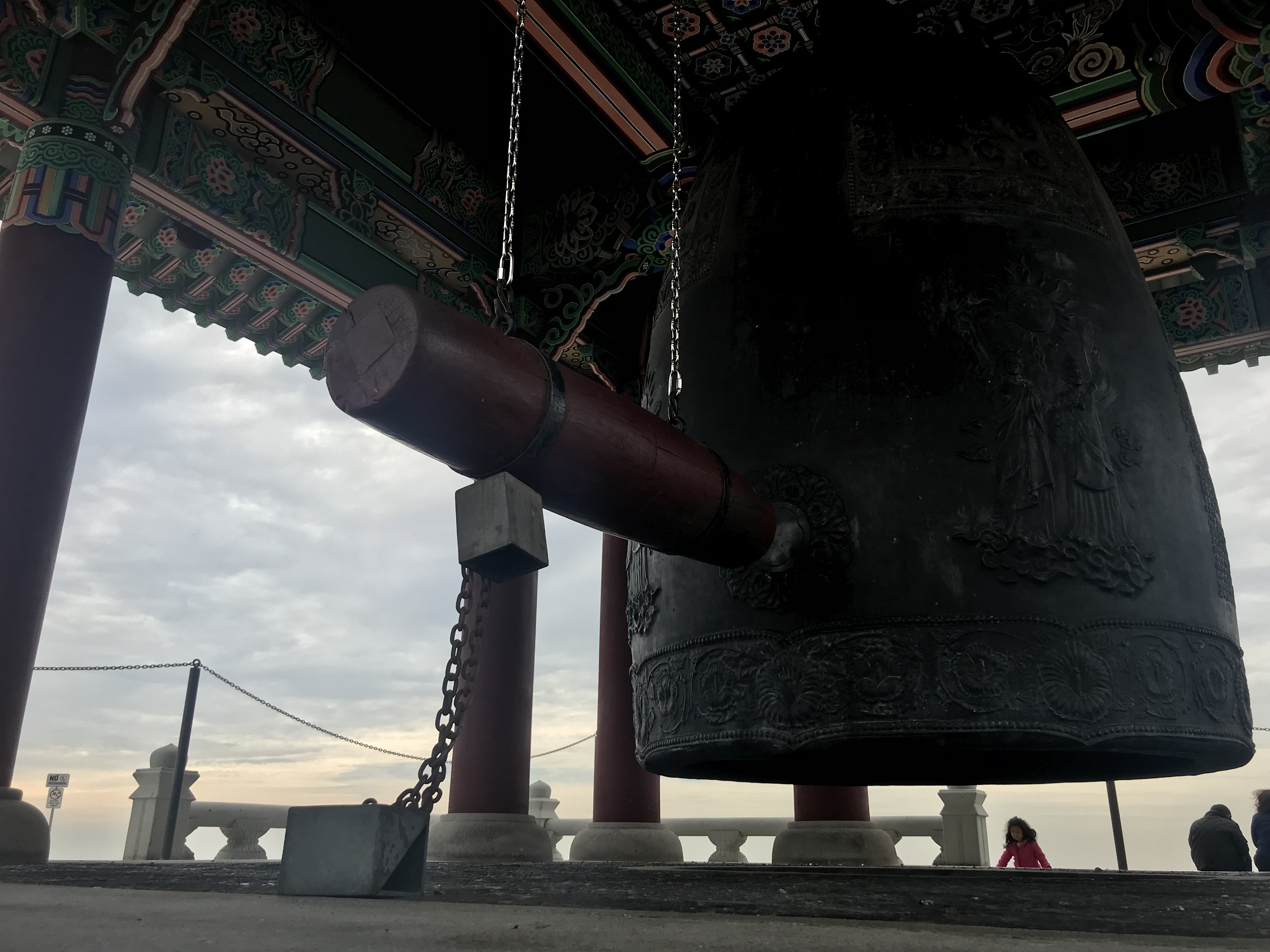
After we arrived in San Pedro, Mike parked his car at Lookout Point Park and we had a look over the bay, although it was shrouded in fog. After that, we walked over to Angels Gate Park, where we checked out the Korean Bell of Friendship (우정의 종), the remains of Fort MacArthur’s gun batteries (constructed from 1916-1919) and the beautiful Point Fermin Lighthouse (built in 1874).


The lighthouse museum offers guided tours, starting at 11:00. Also near the park and of potential interest are the International Bird Rescue and the Marine Mammal Care Center. International Bird Rescue was launched in 1971, after a disastrous oil spill, and rehabilitates injured aquatic birds. The Marine Mammal Care Center treats sick, injured, and malnourished Otarioidea (e.g. seals and sea lions) and a reader tipped me off that feeding times were at 11:00 and 15:00… but as it was 10:00-ish, we moved on.
SUNKEN CITY
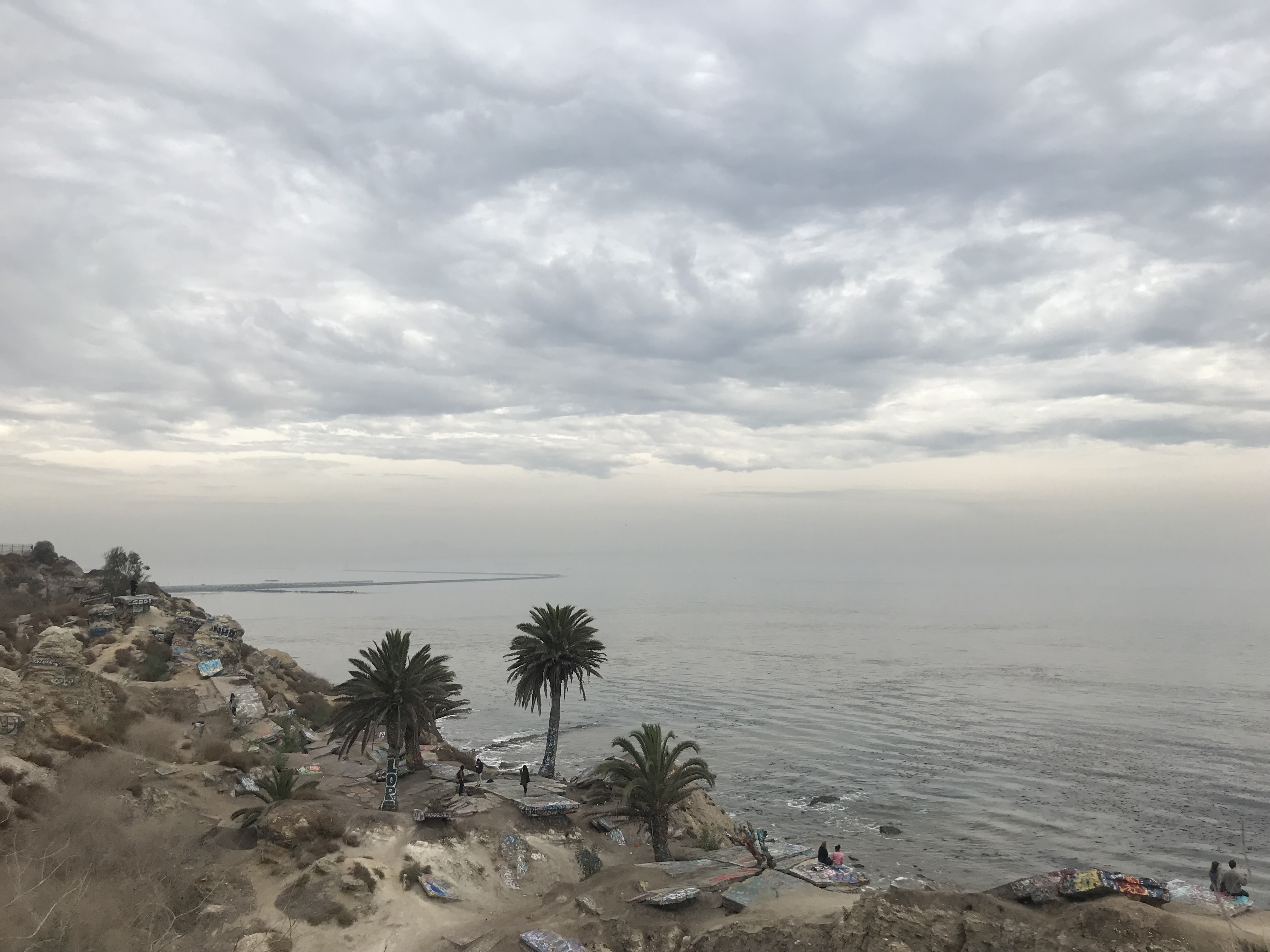
Since Mike’s original wish had been to explore Sunken City, that’s where we went next. In the 1900s, San Francisco developer George Huntington Peck, Jr. began developing a tract of seaside homes called Peck’s Ocean View Tract. On 2 January1929, a water main broke under the Ocean View Inn. A few days later, a gas line broke. Soon it was apparent that the Ocean View Tract was going to offer residents a closer view of the ocean than they’d ever expected as the hotel and their homes began to slowly slide toward the sea. About 30 homes were lifted from their foundations and relocated. Two, however, were too far gone and crumbled, along with a section of Paseo del Mar, into the sea. Today, although numerous signs prohibit trespassers, it’s popular with a generally young crowd of stoners, taggers, photographers, and other scofflaws.
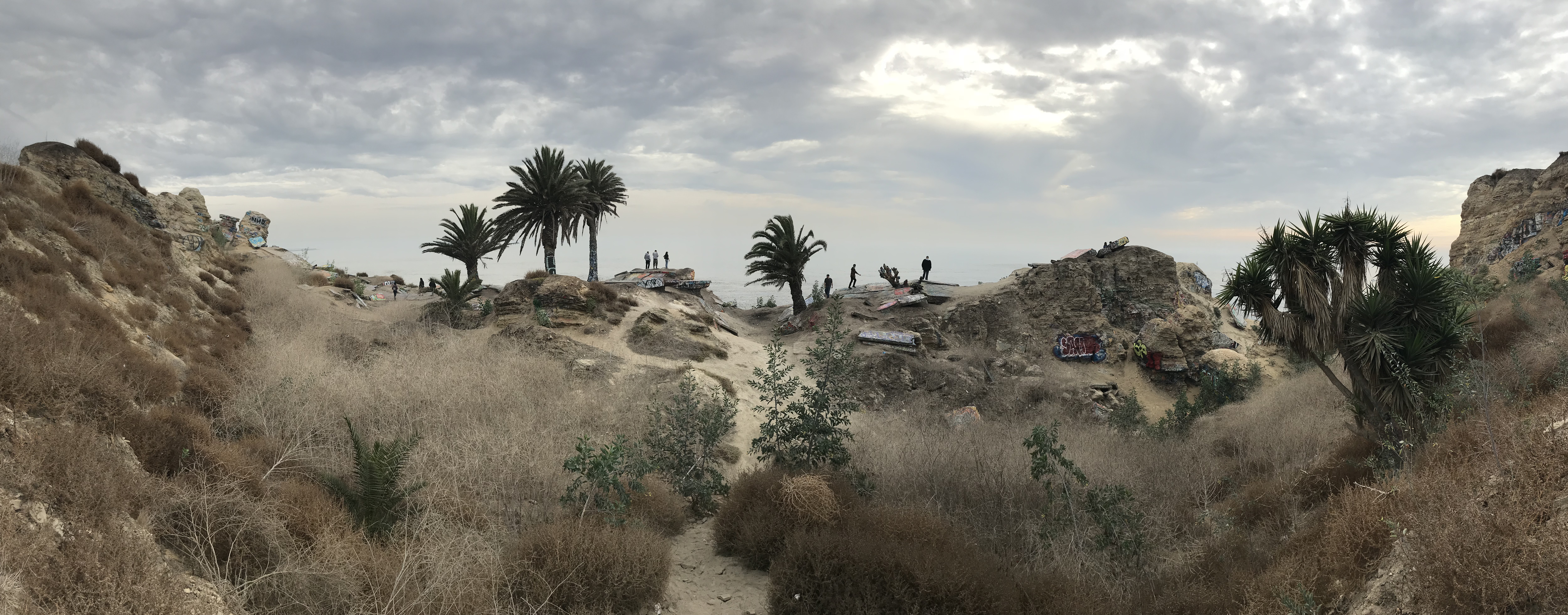
CABRILLO BEACH

Mike and I skipped Cabrillo Beach due to time limitations, but I’ve been there before and can, therefore, assure readers that it’s absolutely worth visiting. Construction of the San Pedro Breakwater began in 1899. Los Angeles Harbor Light (fka the San Pedro Breakwater Light Station and aka Angel’s Gate Lighthouse) was built at the end of the breakwater in 1913. Sand was added to the beach in 1927 and the beach opened the following year. The lighthouse was automated in 1973 and therefore rarely sees human visitors, which seems like a bit of a shame — it would make an amazing vacation rental! Since the early 2000s, a group of lifeguards and others have also annually undertaken what they call the Angel’s Gate Lighthouse Swim. In the summer, people also come to the “grunion run,” when female grunions lay their eggs in the beach and males deposit sperm on them during high tide. Soon after, the eggs hatch and the high tide carries the young grunions out to sea.
The Mediterranean Revival style Cabrillo Beach Bathhouse was built in 1932. It was designated Los Angeles Historic-Cultural Monument No. 571 in 1993. In 1935, the Cabrillo Marine Aquarium began as a collection of specimens in the nearby Cbathhouse. A new structure, designed by Canadian-Angeleno architect Frank Gehry, was completed in 1981. A 2004 expansion was designed by Barton Phelps & Associates.
PERFORMING ARTS
The San Pedro performing arts scene is represented by several theaters and festivals. Every summer, the Shakespeare by the Sea, Los Angeles Festival takes place in Point Fermin Park. The San Pedro City BalletSan Pedro City Ballet was established by Cynthia and Patrick David Bradley in 1994. San Pedro is also home to Elysium Conservatory Theatre, The Space on Pacific, and the Warner Grand and Grand Annex (more on that later).
EATS
Since San Pedro is a harbor community, there’s naturally quite an emphasis on seafood. This being America, where “seafood” refers only to marine animals and thousands of edible “sea vegetables” are brushed off as “seaweed,” it’s perhaps not the most vegetarian-friendly restaurant scene. The best-known community food festival is likely the Port of Los Angeles Lobster Festival, in which people presumably dine on large marine crustaceans which vegetarians don’t eat. However, as a vegetarian whose eaten throughout Los Angeles, I have to assume that nearly every restaurant has at least one meat-free entree.
Local delis, restaurant, food trucks, markets, &c include A-1 Imported Groceries, Alaska Seafood & Sushi, Babouch Moroccan Restaurant, Baramee Thai Restaurant, Beach City Grill, Big Nick’s Pizza, Boardwalk Cafe, Bonello’s New York Pizza, Bunz Gourmet Burgers, Burattino Brick Oven Pizza, Busy Bee Market, Chicago for Ribs, The Chori-Man, The Corner Store, Crusty Crab, Deluxe Waffle, El Habanero MX, Fat Tomato Pizza, Green Onion Mexican Restaurant, Grinder Restaurants – San Pedro, Guanajuato Meat Market, Happy Deli, Happy Diner, Harbor Light 등대 Mini Mart Restaurant Fish & Chips, Jacaranda Gourmet, Jackson’s Place, Jasmine Hana, Joseph’s Bakery, J Trani’s Ristorante, La Bella Napoli, La Cocina de Paquita, Matteo’s Pizza, Nazelie’s Lebanese Cafe, Neil’s Pasta & Seafood Grill, Niko’s Pizzeria, NUDA Juice & Wellness Shop, Omelette & Waffle Shop, Pacific Diner, Pan-Pacific Restaurant, Pappy’s Seafood, Philie B’s, Pinas Cafe, Pirozzi’s Italian Deli, Pokeio, Ports O’Call Waterfront Dining, Prontos Mexican Grill, Puesta Del Sol, Raffaello Ristorante, Rex’s Cafe, The Sandwich Saloon, San Pedro Cafe, San Pedro Fish Market and Restaurant, San Pedro Tacos, Senfuku, Sirinat Thai, Slavko’s, Sonny’s Bistro, Sorrento’s Restaurant, Sushi 21, Tacos Jalisco, Tamale Guy, Teriyaki Table – San Pedro, Think Cafe, 3BBQ, Toyo Bowl, 22nd St Landing Seafood Grill & Bar, and Utro’s Cafe.
Although I normally try to eat at places I haven’t been before when exploring, we were both hungry and thirsty and since Mike was game, we went to The Whale & Ale, an English pub. Of course, I’d be happy with a few more vegetarian options but then I’ve only been there twice so they’re not likely to cater to my personal tastes. I ordered a cream of mushroom soup and a side of fries, both of which proved quite nice.
Not wishing to overdo it, I removed my London sweater and ordered a pint of London Pride. The bartender also let us sample Dog Ate My Homework, a saison brewed at Brouwerij West, which he told us was a local San Pedro brewery. Not long after, a salty dog who was the spittin’ image of Poopdeck Pappy mounted a stool at the bar and barked, “Guinness” and for emphasis added “dark!”

He introduced himself as Timothy and proceeded to regale us with tales, sometimes expectedly salty, of his life as an ironworker and navy man. There were stories of freezing in the North Atlantic, building the Vincent Thomas Bridge and Walt Disney Concert Hall, shanghai-ing unsuspecting out-of-towners, and many more. As we were leaving, he suggested we accompany him to The Alhambra for a real good time. The Alhambra has, apparently, is a real dive bar (e.g. disreputable, cash only), which has sullied San Pedro’s reputation since 1936!
DRINKS
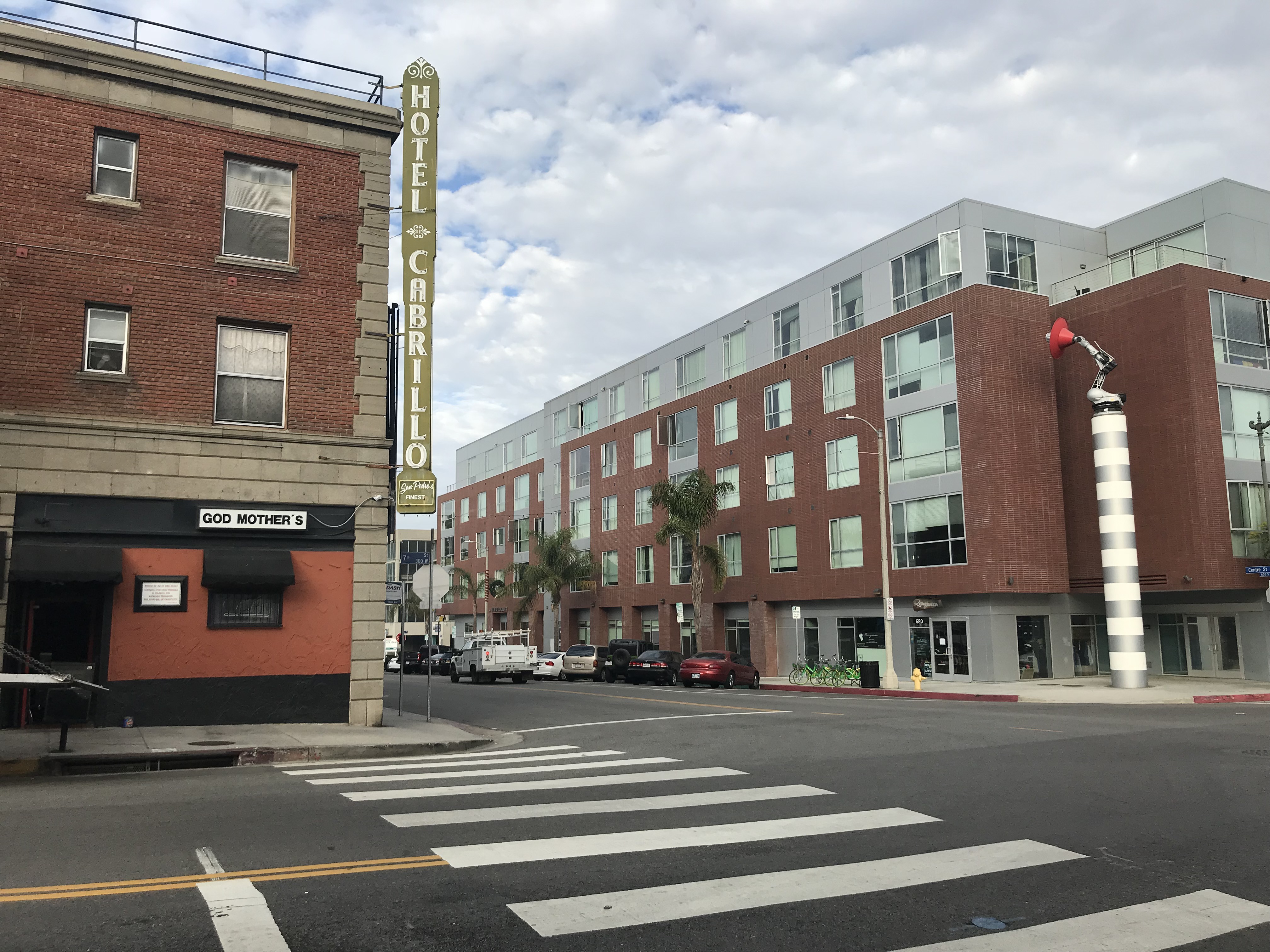
As much as Mike and I appreciated his offer, we weren’t ready to quit exploring yet, although next time I’m in San Pedro, I’ll hopefully visit the neighborhood’s oldest cocktail lounge. If I recollect correctly, I’ve only been to one bar in San Pedro before, the pleasantly rowdy Godmother’s Saloon, taken there by my friend Lars on a Rock ’n’ Roll Monday. I suppose you could also count the shop at Al Larson Marina, where during my exploration of Terminal Island I was sold a $1.50 tall boy after being informed by a group of day drinkers that I looked like I needed a drink.
Other local bars, breweries, pubs, lounges, &c include Auggie’s Tavern Bar, Blu Hookah Bar & Lounge, Enigma Bar, Goodfellas Sports Bar, Harold’s Place, Iron City Tavern, Off the Vine, Port Town Brewery (located in San Pedro’s historic Liberty Auditorium), Rebel’s Cocktail Lounge, San Pedro Brewing Company, and The Spot. Other nightlife and entertainment options include Crimsin (a lounge), El Principe (a nightclub), and, I suppose, the Elks Lodge San Pedro.
L.A. MARITIME MUSEUM/SAN PEDRO MUNICIPAL FERRY BUILDING
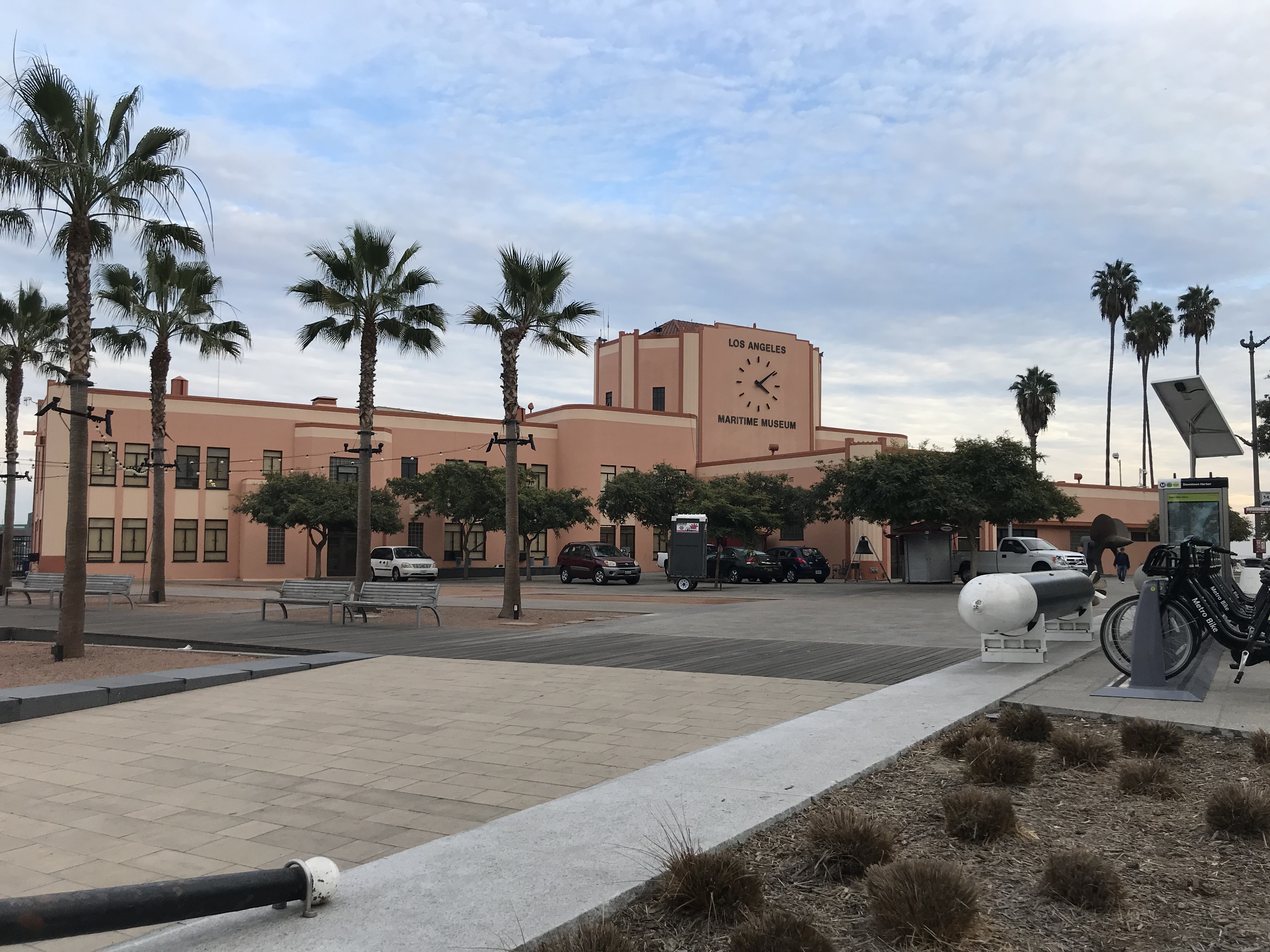
Most cross-channel trips between San Pedro proper and East San Pedro were formerly conducted by ferry. The San Pedro Municipal Ferry Building was built in 1941 and ferried passengers across the channel until 1963. In 1980, it was turned into the LA Maritime Museum. I’ve visited it before and recommend spending some time there but on this occasion, having failed to take advantage of the restrooms at the Whale & Ale, only popped in to use the facilities after an employee took pity on me as I approached a grimy portajohn.
VINCENT THOMAS BRIDGE
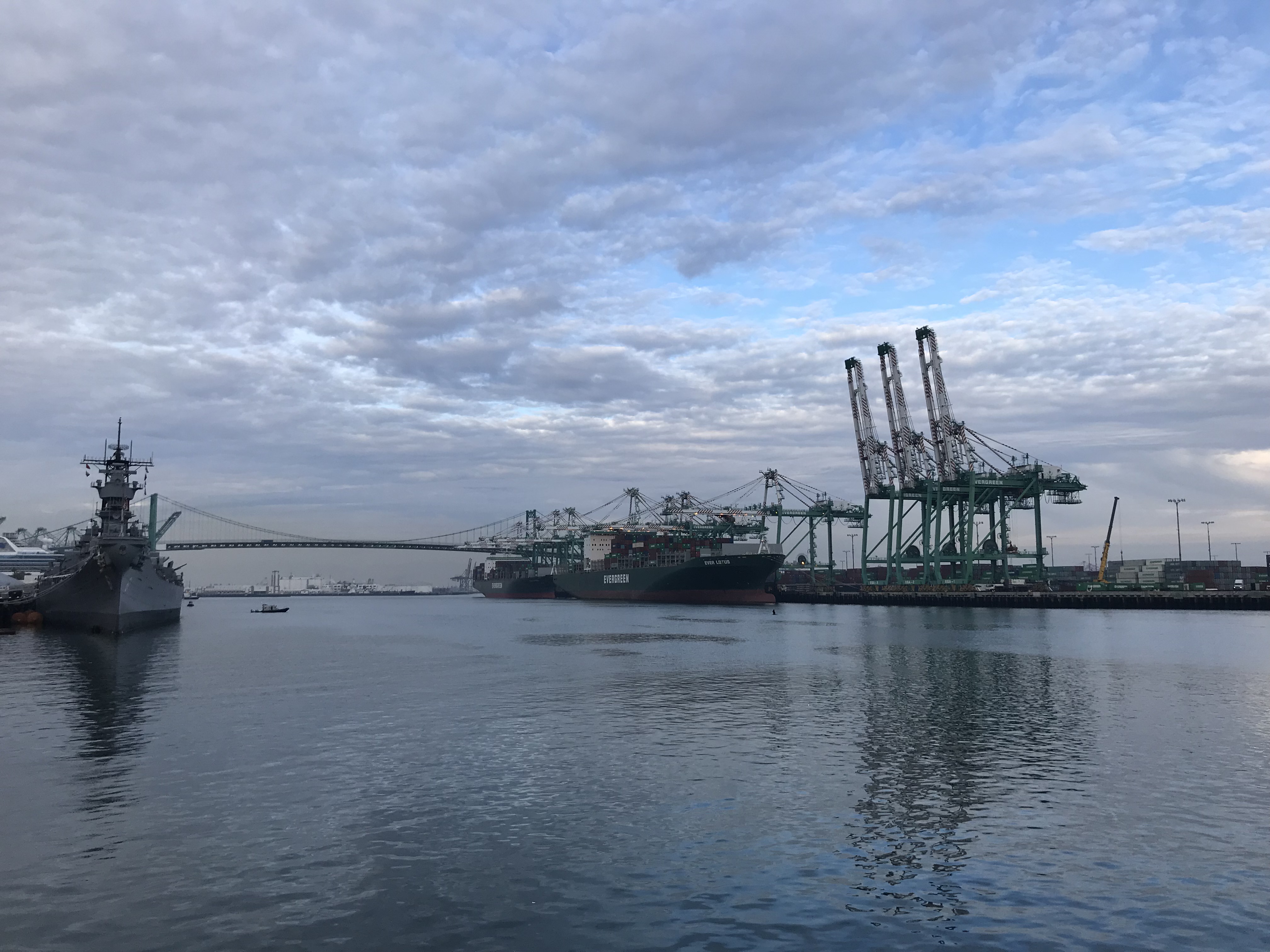
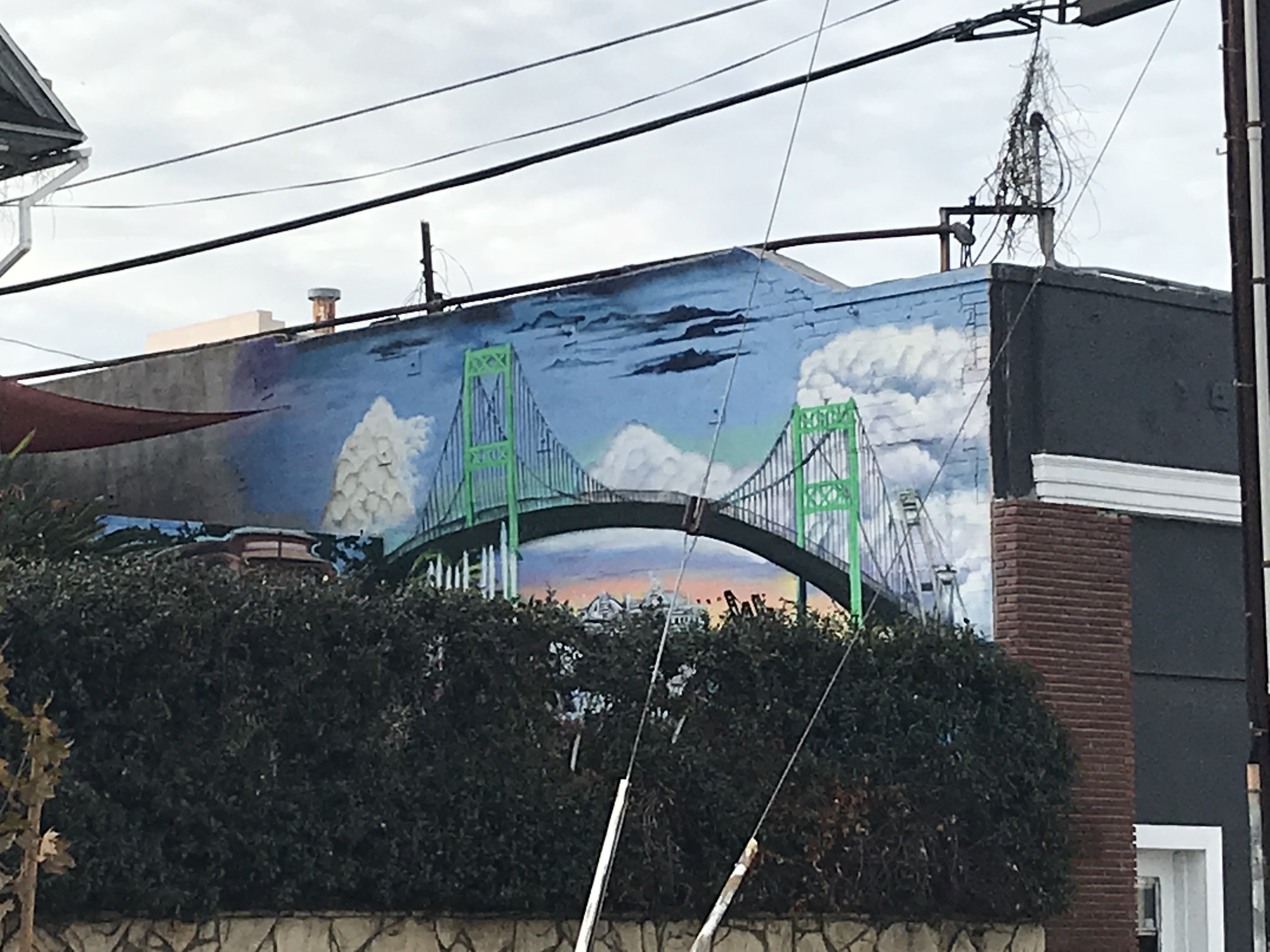
The San Pedro Municipal Ferry Building closed because, in 1963, the 460-meter long, wire suspension, green, Vincent Thomas Bridge was completed. It was built by John A. Roebling’s Sons Co. of Roebling, New Jersey. The bridge is named after Croatian immigrant and California Assemblyman Vincent Thomas (né Vincent Tomasevich), who championed its construction. It’s prominently featured in several films including Gone in 60 Seconds (1974), To Live and Die in L.A. (1985), and Heat (1995). While inarguably a symbol of the neighborhood, to me it’s every bit as beautiful as San Francisco’s Golden Gate Bridge and should rightfully, as with that bridge, be recognized as an icon of the entire city.
PORTS O’ CALL VILLAGE
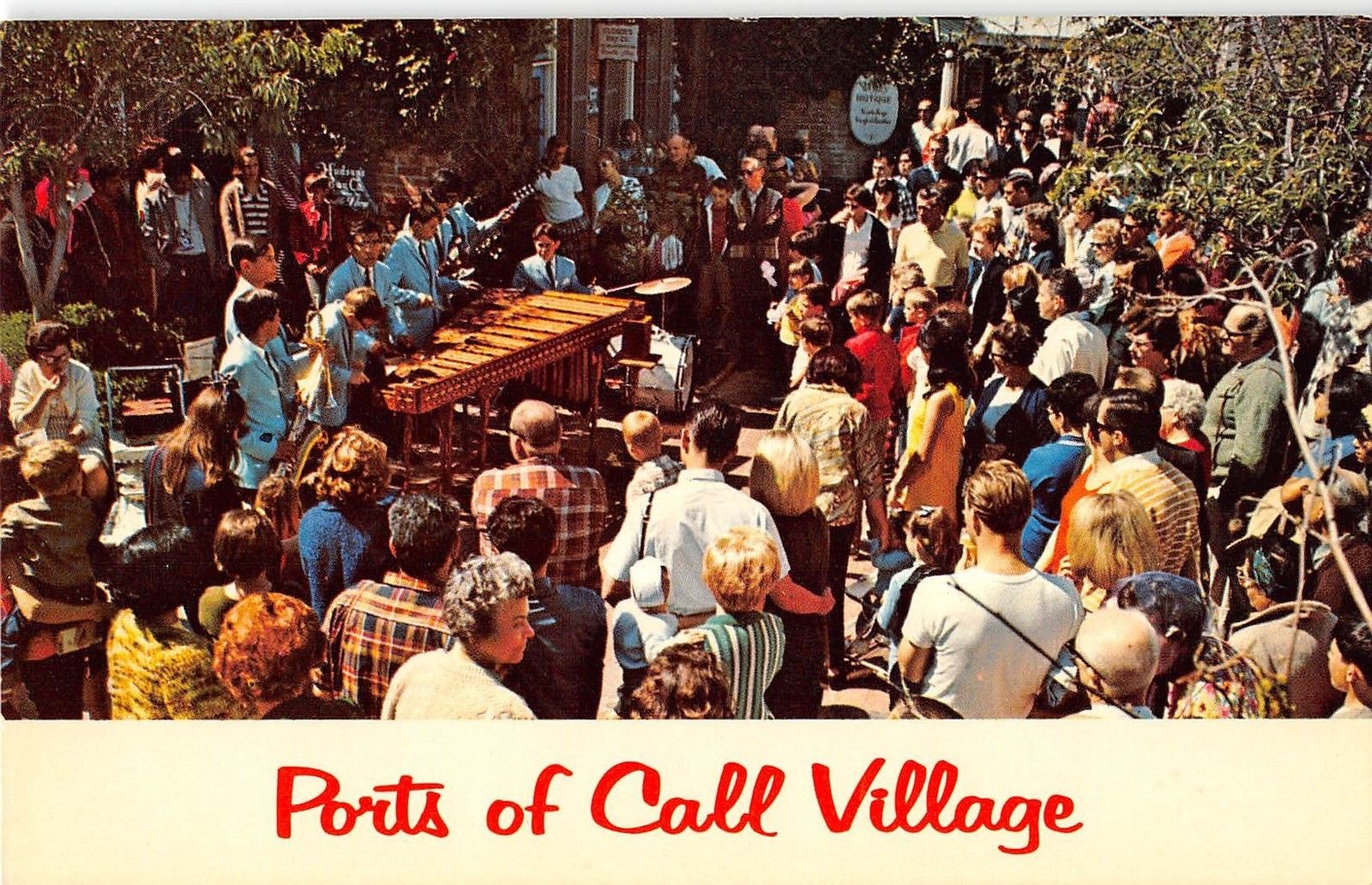
Also built in 1963, and nearly as iconic (at least to me) and beloved is Ports O’Call Village. It was conceived and built by World War II veteran-turned restaurateur, David Compton Tallichet, Jr. Tallichet was a visionary pioneer in the concept of themed restaurants and thus a major contributor to the kitsch culture of Southern California. Inspired by theme parks like Disneyland, Tallichet opened Polynesian-themed restaurants including The Reef in Long Beach and The Castaway in Burbank as well as the aviation-themed Proud Bird in Westchester and the 94th Aero Squadron in Van Nuys.
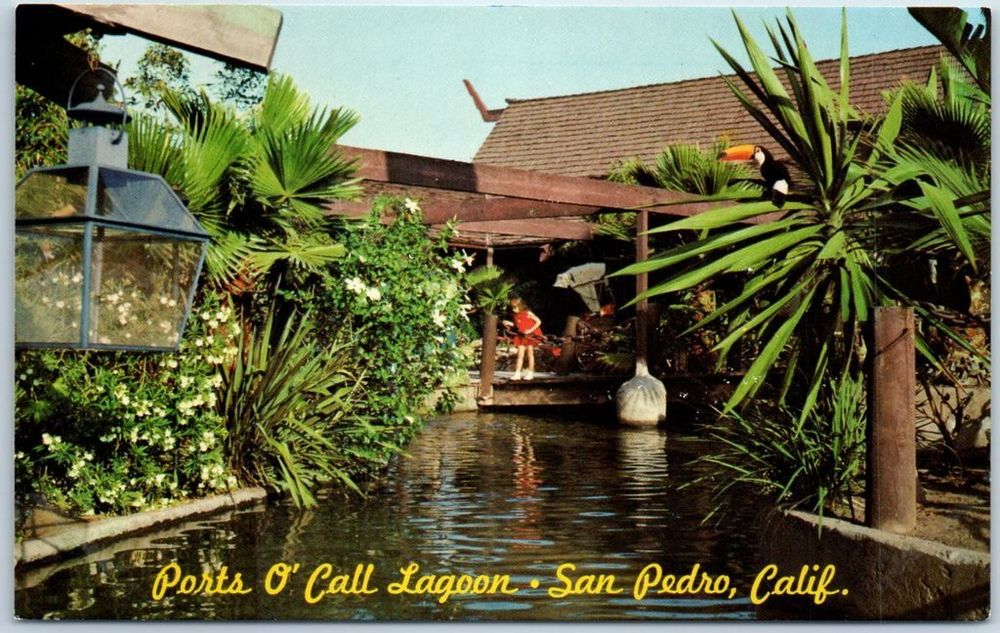
Ports O’Call Village includes a jumble of somewhat run-down businesses located on a disorienting maze of cobblestone streets. One half, the Pan Pacific Village, is dominated by East Asian businesses and announced by the unmistakably Korean Pan Pacific Village Gate. The other side, which opened in 1967, is the New England-style Whalers’s Wharf. Next to it are moored to replica 19th-century windjammers — the Exy Johnson and Irving Johnson. Having nothing to do with either and therefore everything to do with Southern California was the Skytower, which opened in 1974 and, after ending regular operation in 1979, was permanently closed in 1983 and removed.
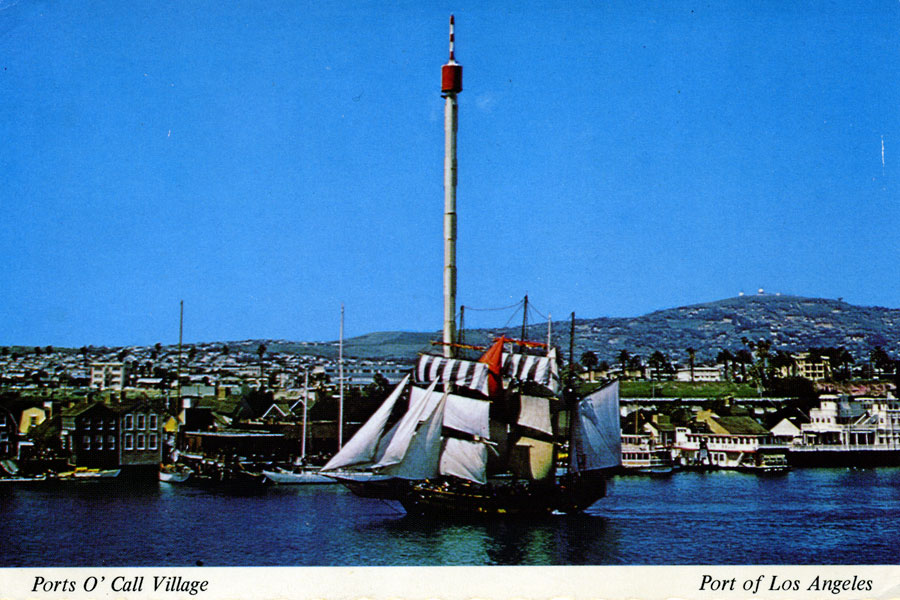
All that, however, is set to be obliterated as developers and politicians are apparently dead-set on transforming the simultaneously charming and menacing plaza with the sort of completely sterile, utterly generic tourist bait that all locals naturally avoid and which Los Angeles already has several of (e.g. Hollywood and Highland, The Grove, LA Live, &c). I’m not one who argues for the preservation of every “historic” structure in Los Angeles, especially when replaced by something better — but San Pedro Public Market (as the new project is named) will consist of shops selling burgers, cheese, juice, pizza, and Greek yogurt, if the renderings are to be believed. In real life, it’s centerpiece will probably be a Hooters or Bubba Gump Shrimp Co.
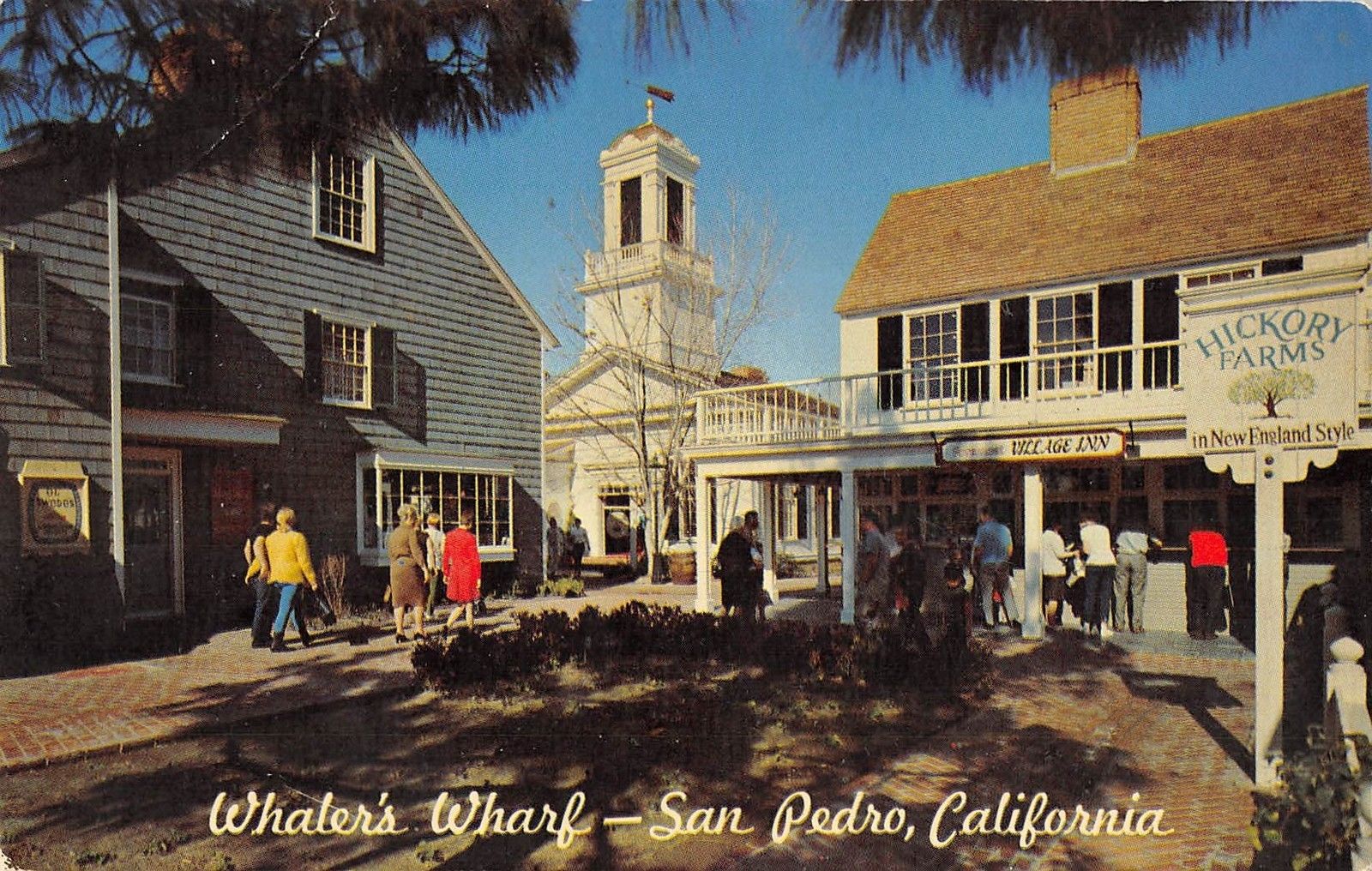
The demolition and redevelopment are being done by the Ratkovich Company and Jerico Development. Eric Johnson, of the latter, explained in an interview on KCRW (with no apparent sense of irony) that “a New England fishing village never made sense to me. We have our own maritime culture. So we’re trying essentially to celebrate California for what it is.” I wonder what he thinks of Alpine Village, tiki bars, Chinatown, English pubs, the Venice Canals, theme parks, Taiwanese píjiǔ wū, the Streamline Moderne Coca-Cola Building, and the huge variety of revival style architecture which accounts for a significant proportion of our city’s built environment and the inauthenticity of which some would argue are exactly “California for what it is.”
Compounding the irony, the 50-year old Korean and New England buildings — which, again, have nothing to do with our culture — are to be replaced with ersatz structures designed to resemble repurposed old industrial structures. The design team of the redevelopment is being led by Bill Taylor and Tim Delaney, the latter of whom has worked extensively for the theme-park operating Disney and Universal studios. In other words, we’re trading one simulacrum for another.
I’m not saying there isn’t room for improvement at Ports O’Call. 20% of the spaces were routinely vacant, which I think added to its Forsbergian charm, but which I’m sure the property owners weren’t exactly thrilled with. I also realize that a carnival-like mix of family fare with palpable menace isn’t exactly a selling point for most would-be visitors — but demolishing an important part of our history and culture to start from scratch seems like a waste when there’s a big, dumb parking lot just begging to be replaced with a superblock of 30-story mixed-use high-rises which, if built and connected to a rail station, would no doubt infuse Ports O’Call with a steady stream of customers.
PORT OF LOS ANGELES WATERFRONT RED CAR LINE
In 2003 the Port of Los Angeles Waterfront Red Car Line began operation on an abandoned right-of-way. Its 2.4-kilometer course was served by two Pacific Electric Railway replicas. There were talks to extend it to the Cabrillo Marine Aquarium, which would be great. Perhaps it could also be extended north to Westmont Drive, where the old tracks end, or even further north along Gaffey to the right-of-way south of Sepulveda and Normandie (which Gaffey becomes), where someday Metro’s Green Line will hopefully be extended. Unfortunately, right now the San Pedro Waterfront Red Car Line doesn’t go anywhere. Service ended in 2015 although one of the few things the San Pedro Marketplace unquestionably gets right is an incorporation of the line into it and a resumption of service.
GETTING THERE AND GETTING AROUND
In the meantime, San Pedro is served on land by Metro’s 205, 246, 444, 445, 446, 447, 450, 550, Rapid 910/950, and the Silver lines; the LADOT’s DASH San Pedro and Commuter Express 142 lines; and Palos Verdes Peninsula Transit Authority’s 225 lines. By sea, San Pedro is accessible by Catalina Express, which connects the neighborhood to Avalon and Two Harbors on Santa Catalina Island. San Pedro is also home to the Port of Los Angeles, Cabrillo Beach Yacht Club, and the World Cruise Center.
There are quite a few bike shares around San Pedro, most, from what I can tell, are operated by San Mateo-based LimeBike, whose bikes are dockless, but apparently a bit flimsy. Metro also launched a bike stare program and has thirteen docking stations in San Pedro and Wilmington.
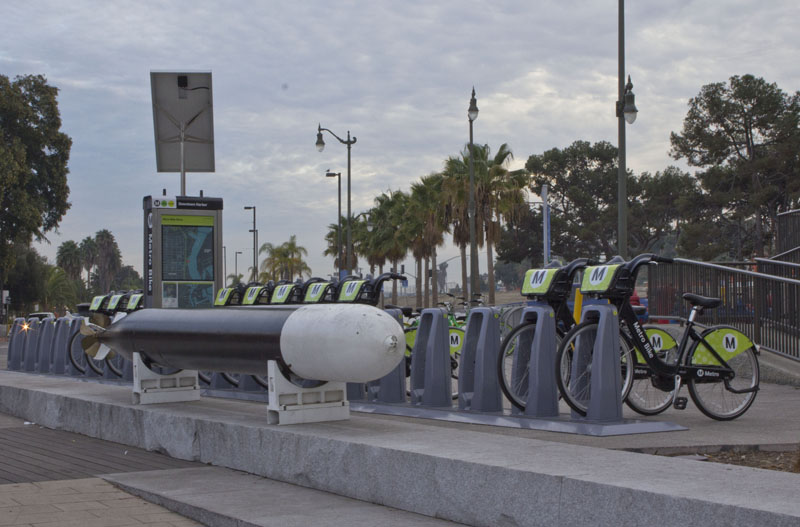
Shortly after Metro’s bike share launch, and before LimeBike’s, the first CicLAVia in the Harbor, took place in August 2017. If you’re into the whole ownership thing, San Pedro is also home to The Bike Palace, a highly reviewed bicycle shop. If you want to join a bicycle club, since 1992 San Pedro has been home to the Peninsula Cycle Club.
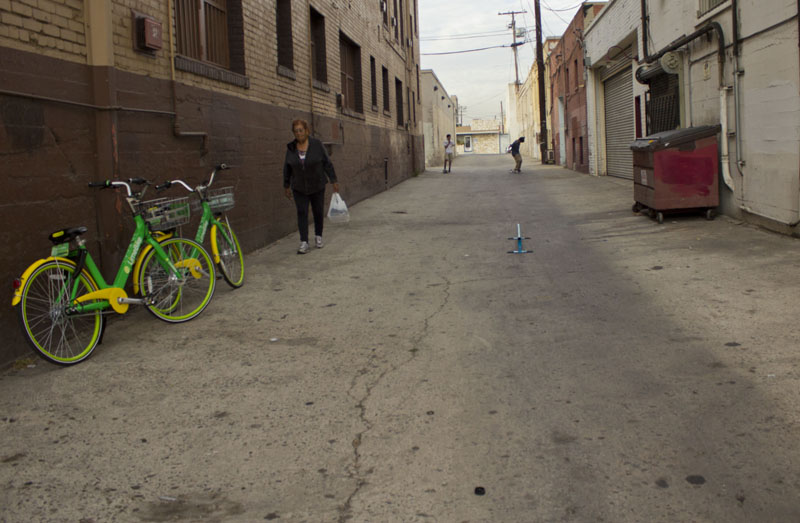
While the LA Waterfront Red Car Line is inoperational, rail fans will perhaps find little to interest them about San Pedro transit, although Metro’s Silver Line, while traveling on a dedicated busway, feels fairly train-like. However, there are two train clubs which might be of interest: Angels Gate Hi-Railers Model Railroad club (AGHR) and the Belmont Shore Model Railroad Club, both located in Angels Gate Park. Belmont Shore Model Railroad Club is an N scale one, launched in the basement of a Long Beach hobby shop in 1971. After stints in Signal Hill and Bell, it took up its current residence in San Pedro in 1979. AGHR is an O scale model railroad, founded in 1995 when members of the Valley Toy Train Club’s Tinplate Trackers O-gauge modular group moved around the corner from the Belmont Show Model Railroad Club.
LAWNCHAIR LARRY
There are other ways to get around, of course, for the committed (or committable). One famous San Pedro eccentric was Lawrence Richard Walters, a truck driver who earned the nickname “Lawnchair Larry” on 2 July 1982 when he tied 45 helium balloons to a patio chair and took to the air on a contraction he named Inspiration I. The airship ascended to an altitude of 4,600 meters and, after 45 minutes of flight, the pilot descended by shooting several balloons with a pellet gun. Unfortunately, he dropped said gun and eventually drifted into some power lines, causing a blackout on Long Beach as a result. He was then arrested and charged with operating a “civil aircraft for which there is not currently in effect an airworthiness certificate.” The charges were later dropped. In 1993, at the age of 44, Walters commit suicide in Angeles Forest.
SAN PEDRO AND FILM
Another colorful San Pedran was Rawlan “Tank” Nelson. Tank was born 11 November 1932 in San Pedro and graduated from San Pedro High School in 1951. After high school, he served in the navy. He married Nola Louise Engh, with whom he had four children, and worked on the San Pedro docks for 44 years. Nola died in 1982 and Tank remarried Terry Crowe in 1983. After retirement, Tank discovered a second career as a movie reviewer. His reviews were initially posted on a chalkboard suspended from his second-floor apartment in the 1990s, and his brilliant sign-off for each was “Laugh Lots!” He died in 2011, at the age of 78.
San Pedro itself has been a filming location and setting for several films not already mentioned, including The Street with No Name (1948), Commando (1985), Summer School (1987), Starsky & Hutch (2004), Faster (2010), Mega Shark vs. Kolossus (2015). It’s also been featured in episodes of the television series Death Valley Days, Perry Mason, Adam-12, Mod Squad, Emergency!, The Bionic Woman, CSI: Miami, NCIS: Los Angeles, Face Off, and The Fosters. San Pedro also hosts the San Pedro International Film Festival and HP Lovecraft Film Festival-Los Angeles. There is also Lisa & Jack Quality Movies & Games, a video rental place operating since 1998.

San Pedro has been home to several closed (and in perhaps all cases demolished) theaters, including Alhambra Theater (c. 1913 – c. 1915), Barton Theater (1925 – c. 1951, 211 N. Pacific Avenue), Fox Cabrillo Theatre (1923 – 1958), Globe Theatre (1915-1971), San Pedro Drive-In (1949 – c. 1972), Strand Theatre (1923 – c. 1974), Victoria Theatre (1918 – c. 1929). The only remaining theater is the Warner Grand Theatre, a (originally) 1,598-seat art deco cinema designed by architect Benjamin Marcus Priteca and interior designer Anthony Heinsbergen which opened in 1931. It was nearly demolished in 1995 but saved by a group of activists known as the Grand Vision Foundation. Today the theater hosts live music and arts education.
MUSIC OF SAN PEDRO
Regarding music, San Pedro has produced a few artists of note. Probably the most celebrated band is The Minutemen. After their singer, D. Boon, died in an automobile collision, the surviving members carried on as fIREHOSE. San Pedro also produced progressive pop band Ambrosia, pop-soul singer Miguel, hip-hop group People Under the Stairs, as well as musicians Chuck Dukowski (Black Flag), Eric Erlandson (Hole), and Jim Korthe (Phantasm). Aside from Warner Grand Theatre, there’s another live music venue called Alvas Showroom, a small venue that seats about 80. Music schools and instrument shops include Gray School Of Music and Guitar Safari. Apparently, JDC Records, is the neighborhood’s only record shop, and Mike and I duly paid them a visit. Facing me when I walked through the door was a 12” of Gazebo’s “Telephone Mama,” which is an essential purchase for any record-collecting Italo-head or Vietnamese New Waver — but I passed on the purchase as it just seems impossible at this point in my life, to to attempt to purchase physical copies of every song I love.
ART OF SAN PEDRO
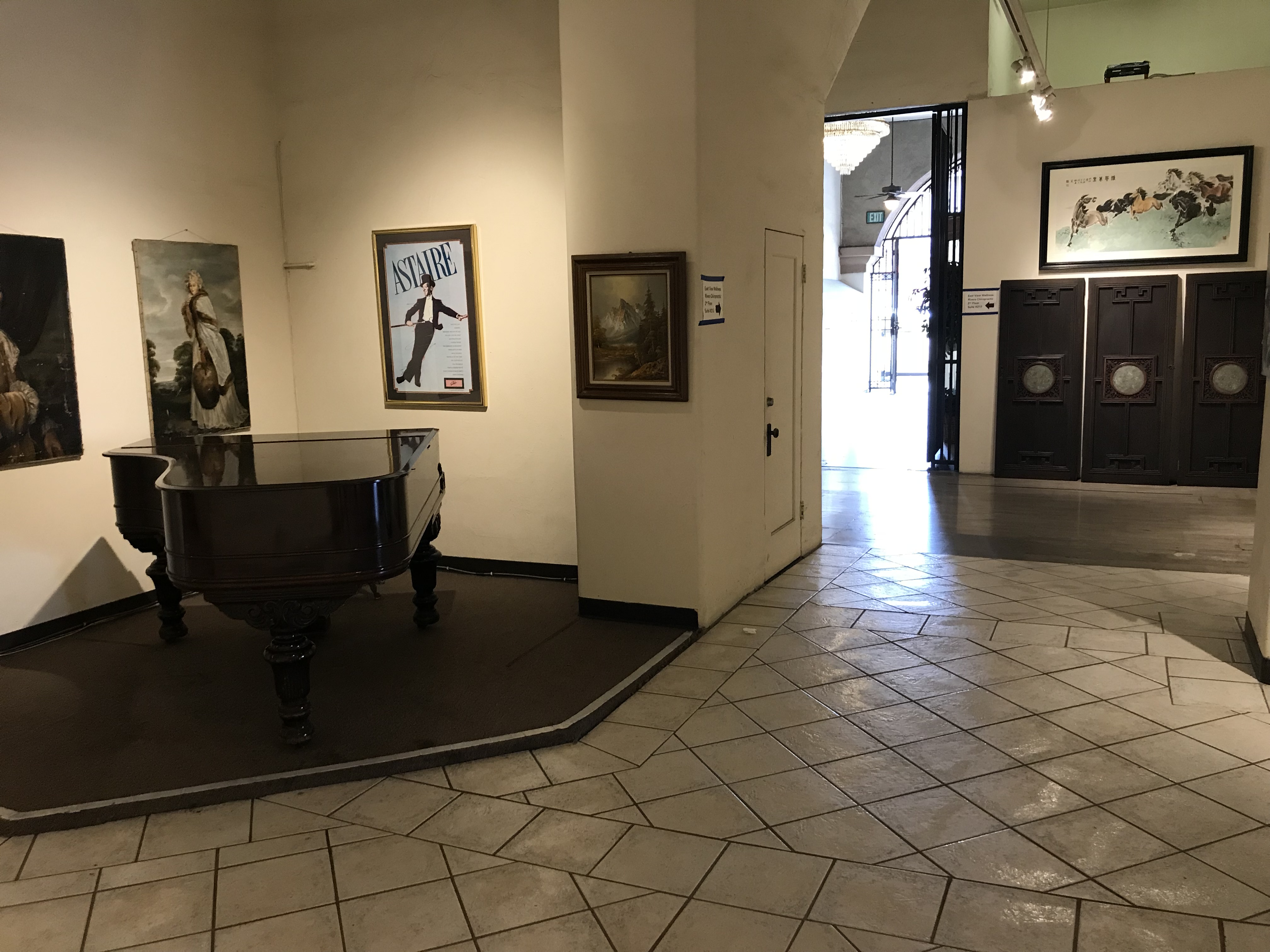
After we left JDC Records, we walked into a two-story office building built in the 1940s and which contained a grand piano and some art. This part of San Pedro is, after all, known as San Pedro Waterfront Arts District (Los Angeles is home to several arts districts, including the Downtown Arts District, the NoHo Arts District, and the Culver City Arts District, which despite its name isn’t actually located in Culver City. The San Pedro 1st Thursday Artwalk takes place on first Thursdays and is organized by the San Pedro Art Association, established in 1936. Last year, the San Pedro Historic Waterfront Business Development District and the San Pedro Waterfront Arts District hosted a summer series called 3rdSaturday ArtWalk. San Pedro also hosts the San Pedro Festival of the Arts and San Pedro Tri Art Festival. Warehouse No. 10 is home to the Crafted at the Port of Los Angeles craft fair.
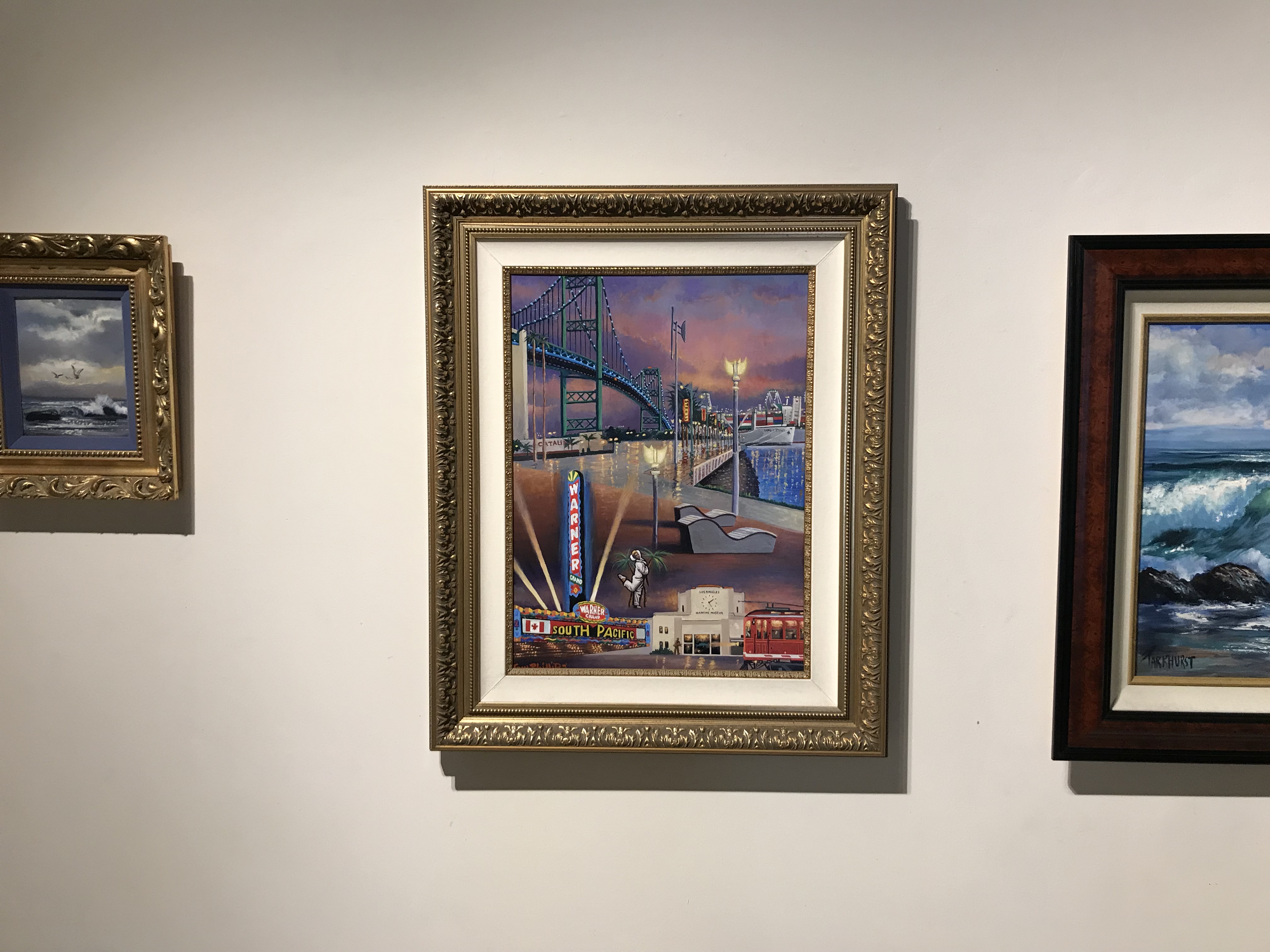
Angels Gate Cultural Center is home to art galleries and offers art classes and cultural programming. Art galleries and organizations in San Pedro include Aicher’s Pop Kustom Shoppe, Bits O’ Gold Fine Arts & Animal Communications, Pins & Needles Underground, Point Gallery, South Bay Contemporary SoLASouth Bay Contemporary SoLA, Templo Studios, 3 Sheets Art Space-Workshop, and Warschaw Gallery.
There’s also quite a bit of both street art and public art in San Pedro in the form of murals and sculptures. Public art pieces include Carl Cheng’s Ghost Fish 107, Mark Dion’s Ship in a Bottle (2011), Doug Hollis’s Telltales Wind Ensemble, Francesco Perilli’s Multicultural Man, Julie Bender’s Catalina Swimmers, and Miriam Jackson‘s Reality Rewritten. John S. Gibson Junior Park is home to a collection of memorials and statuary, including the American Merchant Marines Veterans Memorial, the Fishing Industry Memorial, the San Pedro Fishermen’s Memorial, and the U.S.S. Los Angeles Naval Monument.
SAN PEDRO BOOKS
San Pedro has a literary life too. Comic poet Richard Armour was born there in 1906 when San Pedro was still its own municipality. That year, local newspapers The San Pedro Daily News and The San Pedro Pilot merged to become The San Pedro News-Pilot, which published until 1998 and was San Pedro’s longest-published newspaper. San Pedro was also the hometown of author David Brodsly, whose L.A. freeway, an appreciative essay was published in 1981. The San Pedro Regional Branch Library opened in 1983 and local bookstores include The Grand Emporium (which also sells music and film memorabilia) and Christian Books & Supplies.
ARCHITECTURE OF SAN PEDRO
Although San Pedro has its own downtown, unlike those of many Los Angeles neighborhoods, its skyline is punctuated by a handful of buildings which could liberally be described as skyscrapers. The older of the two, the twelve-story Harbor Towers, was built in 1976. Eleven-story Pacific Place was completed in 1990. 59-meter tall, sixteen-story high-rise, The Vue, was finished in 2008. Next door, the Crowne Plaza Los Angeles Harbor Hotel was also completed in 1990. Shorter and older is the John S. Gibson Jr. Municipal Building, often referred to locally as “San Pedro City Hall,” which of course it was 109 years ago. On the seventh floor is the old jail, jokingly nicknamed “Seventh Heaven.” On the ground floor is Old Fire Station 36 — now a firefighters museum which I’ve never been inside as it’s only open on Saturdays.
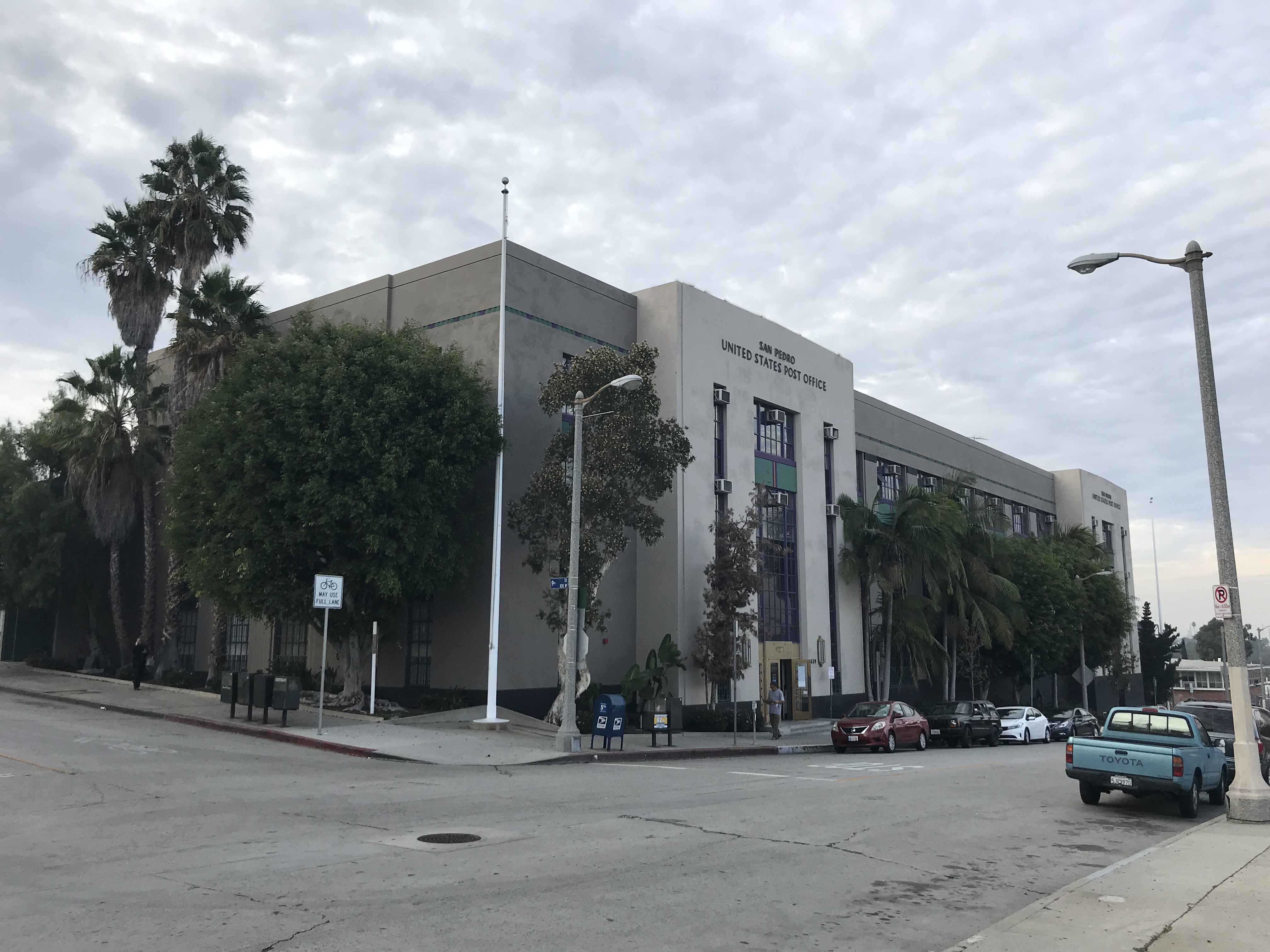
A block south is an art deco post office built in 1936 as by the Works Progress Administration (WPA). Like most WPA works, the interior is beautiful, employing marble tile, bronze, and milk glass in its construction. There’s also a mural designed by Louis A. Simon and Fletcher Martin titled “Mail Transportation.” As I searched in vain for a public restroom, I discovered the San Pedro Postal Museum, which opened in 2000 but is open to the public by appointment only.
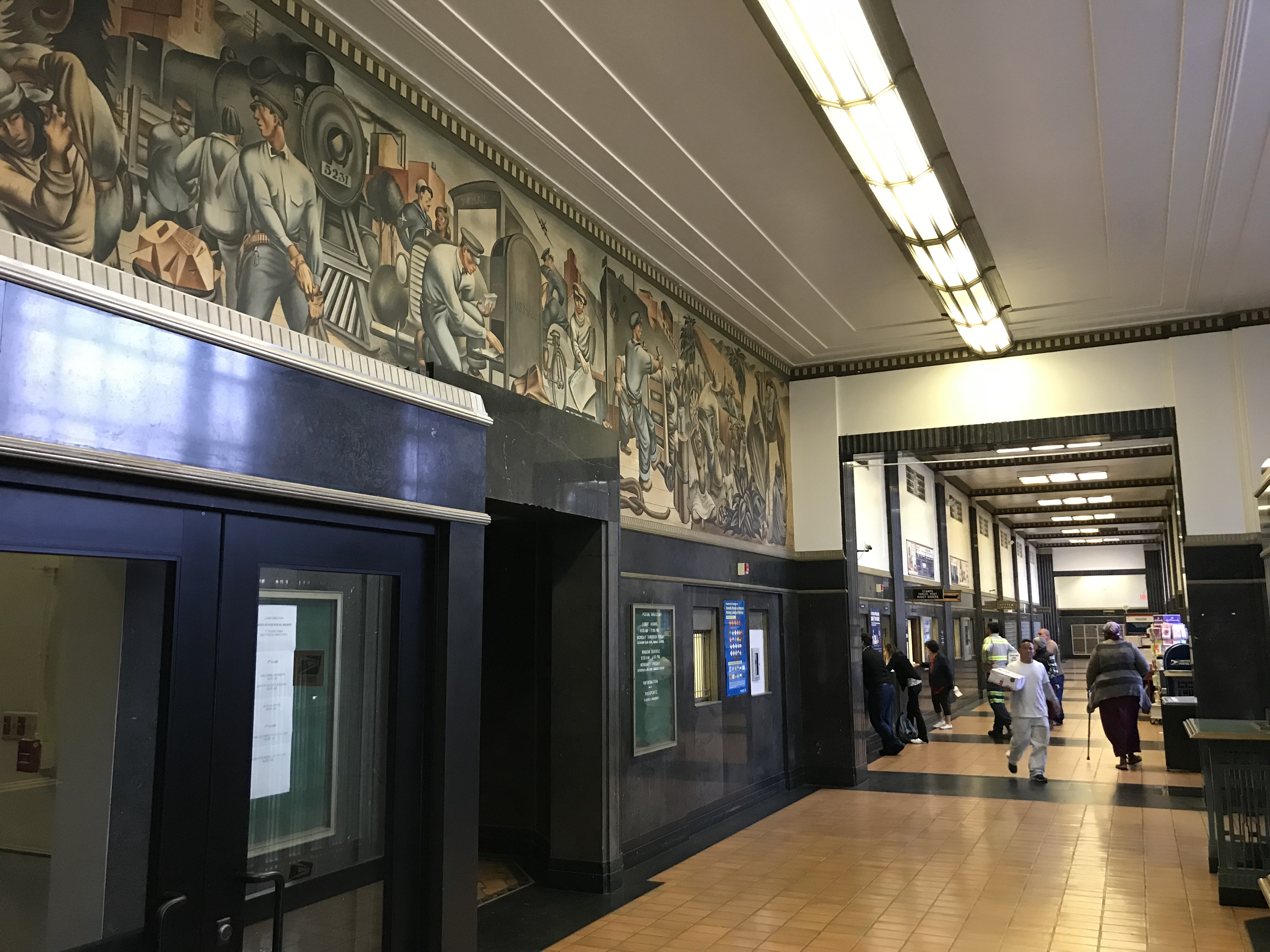

As the sun began to set, we made our way back from the waterfront by walking through the nine-hectare Rancho San Pedro Housing Project. The projects, designed by Pasadena-based architect Reginald Johnson, were built between 1939 and 1941. A later phase was constructed without Johnson’s involvement, in 1951 and ’52. As with many housing projects, the government never adequately maintained the property and by the 1970s, control of the projects was practically ceded to two rival gangs, Rancho San Pedro and the Dodge City Crips. There are plans to redevelop the area into a higher-density, mixed-income development.
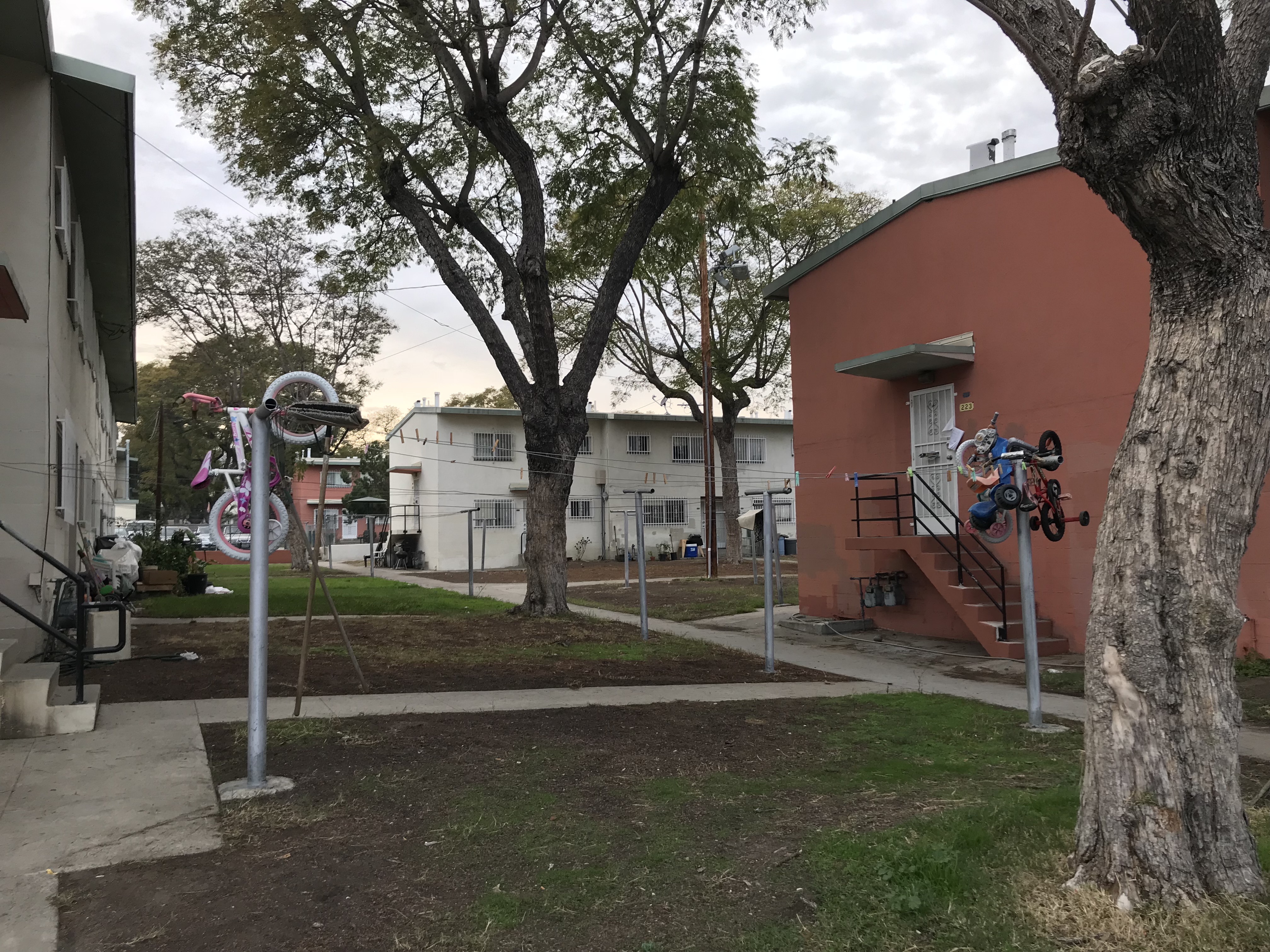
San Pedro used to be home to another housing project known as Channel Heights, designed by the great Richard Neutra in 1942. As part of the project, he also designed furnishings such as his Boomerang Chair, the Channel Heights Stool, and an interesting table lamp, one of which appeared in a Julius Schulman photograph of the projects (and only two of which are known to exist today). Many of the projects residents were war workers and veterans, but after the defeat of the Fascists in World War II, conservatives turned their attention to battling Communism, and during the “Red Scare,” providing housing for the poor, elderly, and veterans was — since a socialist practice — routinely characterized by Republicans as un-American. In 1952, Housing Authority of the City of Los Angeles took over Channel Heights, deliberately allowing the projects fall into disrepair. Neutra’s beautiful homes were closed in 1955 and reduced to rubble not long after.
BROUWERIJ WEST

Before we departed from San Pedro, Mike and I decided to head to Brouwerij West, the brewery that the bartender at the Whale & Ale had mentioned. I picked up a four-pack of the saison that we’d tasted earlier and Mike and I relaxed over a couple of pints in the cavernous brewery and tasting room. In the courtyard, a food truck awaited customers although according to the website, outside food is allowed as well. Of the few patrons at that hour, there was at least one family with a child and a dog in tow. The brewery opened in 2016, inside a 70-year-old Navy receiving warehouse next to the Crafted at the Port of Los Angeles marketplace. The operation is entirely solar powered and of equal importance, the beer was pretty damned good.
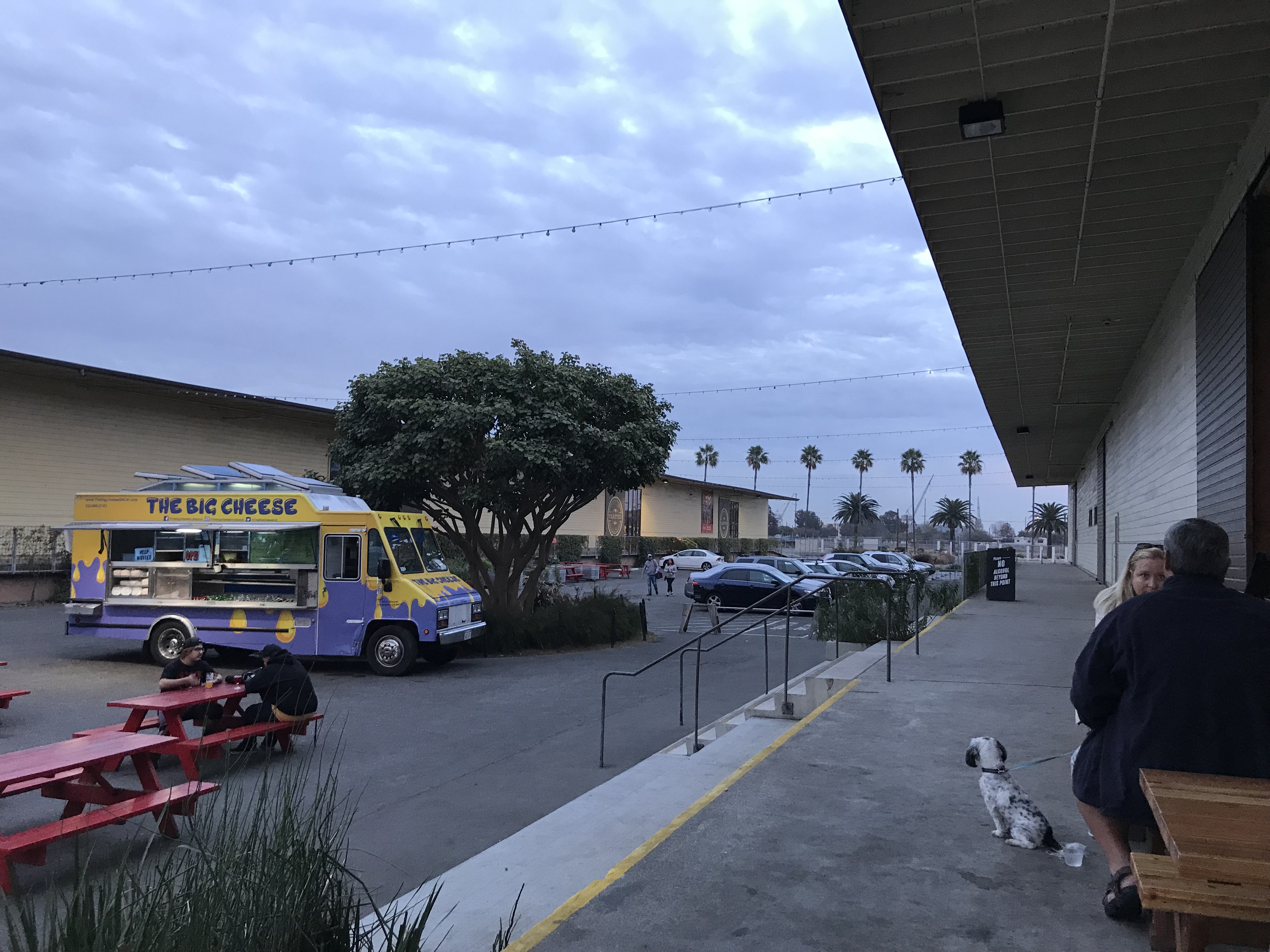
TERMINAL ISLAND
After we left Brouwerij West, we decided that we had to cross Vincent Thomas Bridge and after that, pay a brief visit East San Pedro, on Terminal Island. We slowly drove down darkened streets past container terminals, big rigs, and darkened buildings — many of which have a worn, industrial charm and interesting history. We drove by Nanka Company Dry Goods Store and A. Nakamura Company Grocery Store — pretty much the only remnants of Furusato. I pointed out the US Custom House, Canner’s Steam Plant, Pan-Pacific Fisheries Cannery, the Al Larson Boat Shop and marina where Timothy said he used to live. As we approached Federal Correctional Institution, Terminal Island, I suggested that we turn around in order to avoid any unwanted exchanges with the law officer sitting in a car at the gate. We headed home.
MORE SAN PEDRO
- The San Pedro Bay Historical Society (formed in 1974)
- Visiting…With Huell Howser, “Cannery” (1996)
- The Lost Village of Terminal Island (2007)
- San Pedro’s Cabrillo Beach (Mike Schaadt and Ed Mastro, Images of America, 2008)
- Big Orange Landmarks: No. 146 – Municipal Ferry Building (“Floyd B. Bariscale”, 2008)
- “Fishing for history in LA: Terminal Island, Port of Los Angeles” (Anca Giurgiulescu, Untapped Cities, 2012)
- Cargoland (KCRW, 2014)
- “Discover LA’s ‘Sunken City’” (Off-Ramp, 2015)
- Terminal Island: Lost Communities of Los Angeles Harbor (Naomi Hirahara and Geraldine Knatz, 2016)
- “The lighthouse keepers of Los Angeles” (Hadley Meares, Curbed LA, 2016)
Support Eric Brightwell on Patreon

Eric Brightwell is an adventurer, essayist, rambler, explorer, cartographer, and guerrilla gardener who is always seeking paid writing, speaking, traveling, and art opportunities. He is not interested in generating advertorials, cranking out clickbait, or laboring away in a listicle mill “for exposure.”
Brightwell has written for Angels Walk LA, Amoeblog, Boom: A Journal of California, diaCRITICS, Hidden Los Angeles, and KCET Departures. His art has been featured by the American Institute of Architects, the Architecture & Design Museum, the Craft Contemporary, Form Follows Function, Los Angeles County Store, the book Sidewalking, Skid Row Housing Trust, and 1650 Gallery. Brightwell has been featured as subject in The Los Angeles Times, Huffington Post, Los Angeles Magazine, LAist, CurbedLA, Eastsider LA, Boing Boing, Los Angeles, I’m Yours, and on Notebook on Cities and Culture. He has been a guest speaker on KCRW‘s Which Way, LA?, at Emerson College, and the University of Southern California.
Brightwell is currently writing a book about Los Angeles and you can follow him on Ameba, Duolingo, Facebook, Goodreads, Instagram, Mubi, and Twitter.




Very much enjoyed reading your essay/article. I’m a native San Pedran (but moved away years ago) but am sadly ignorant of much of the history of the place (and I’m a high school Social Studies teacher!). This article brought me waves of nostalgia and made me chuckle more than once.
LikeLike
Glad you liked it. It’s always nice to read comments like this!
LikeLike
Eric,
Interesting article, enjoyed reading. I was thinking about the smoke that early settlers referenced. I wonder if it may have been from the old sulfer springs at White’s Point. There was even a resort there around the early 20’s. An earthquake closed up the vents and water flow.
http://blogs.dailybreeze.com/history/2010/06/02/white-point-hot-spring-hotel/
Mike
LikeLike
Interesting theory! According to some sources, the Spanish noted the presence of smoke throughout their journey along the coast — but if that were the case, why would they have singled out the San Pedro Bay as the bay of smokes? It seems to me that the smokiness must’ve been more than just temporary or run-of-the-mill so maybe it was a sulfur spring!
LikeLike